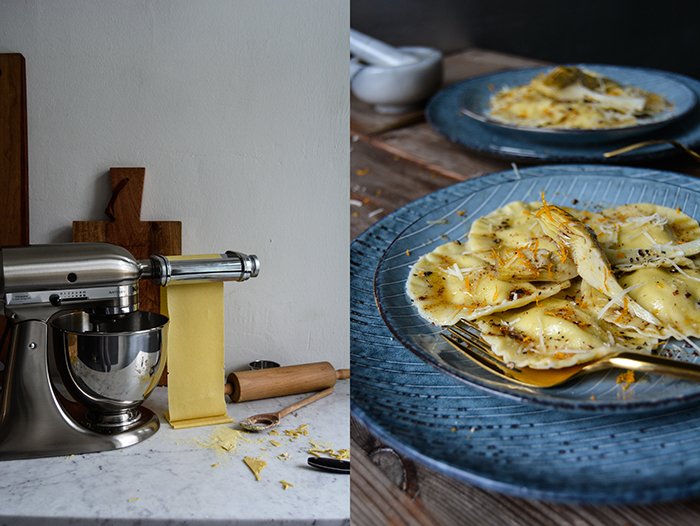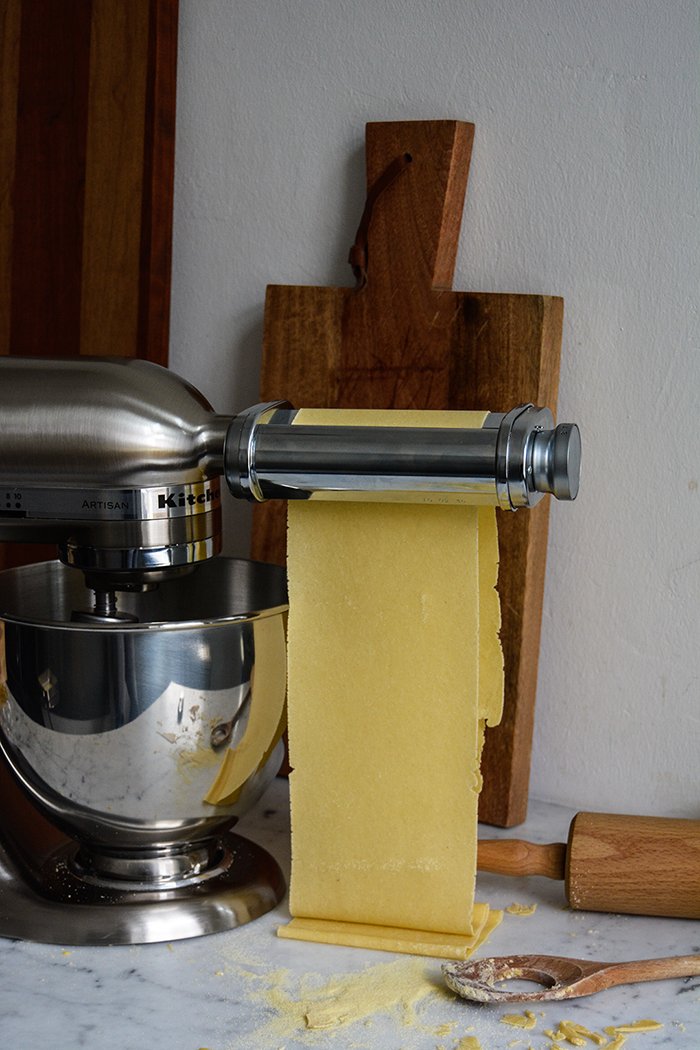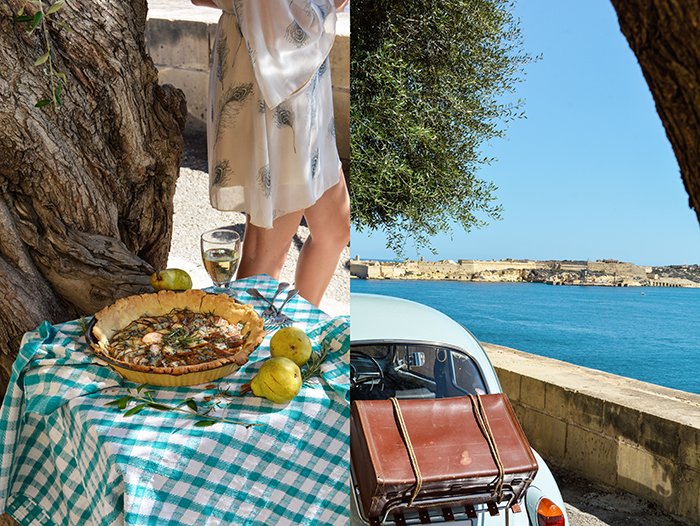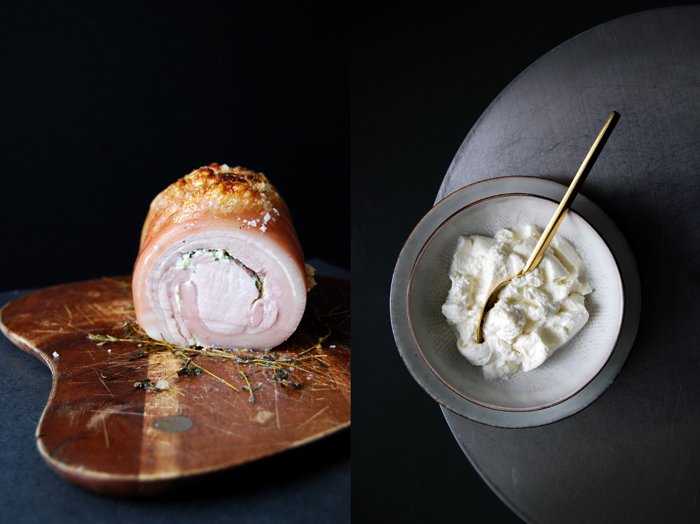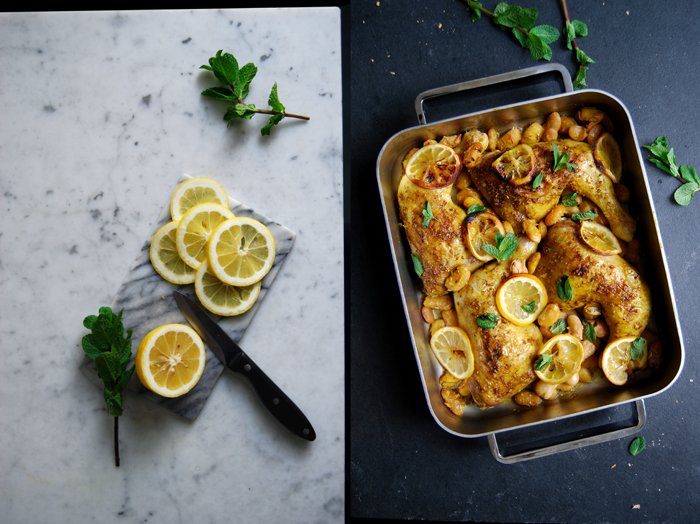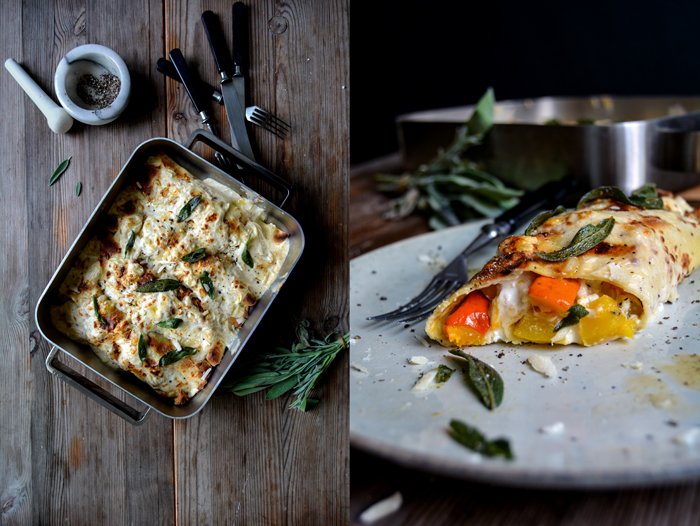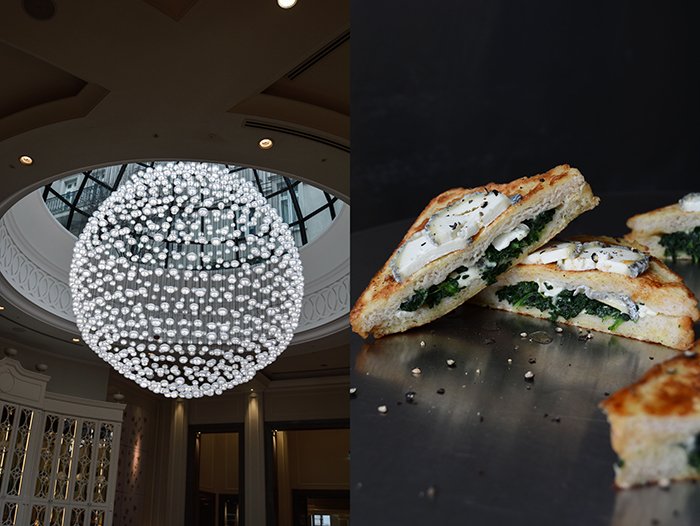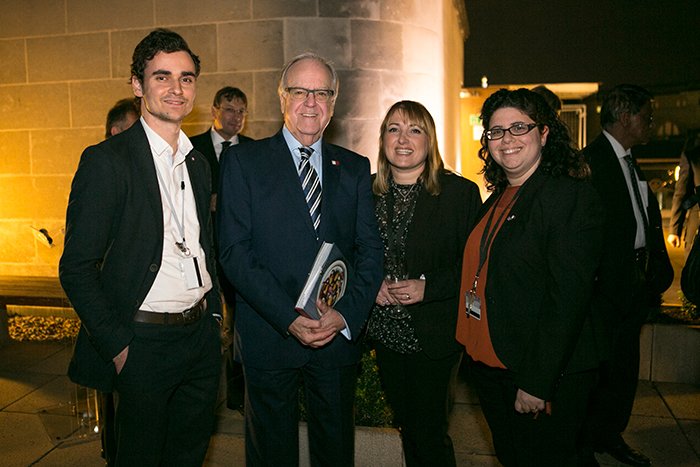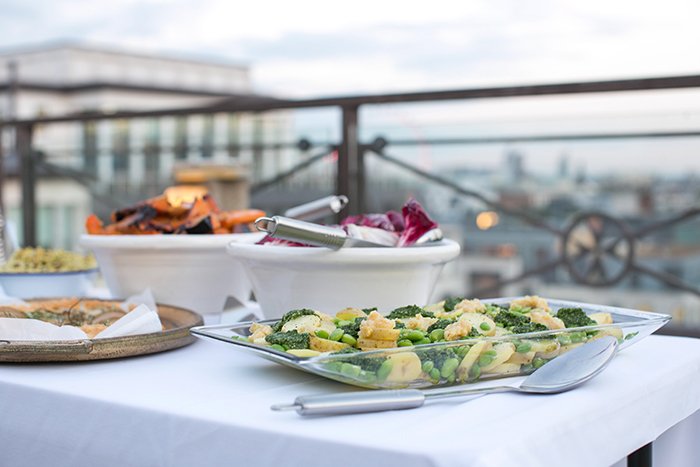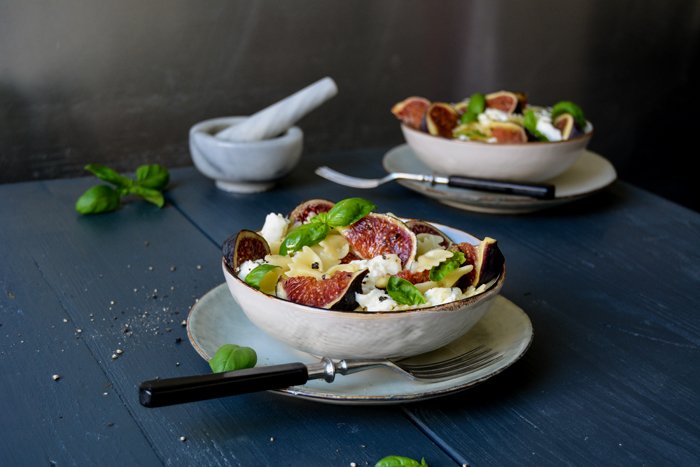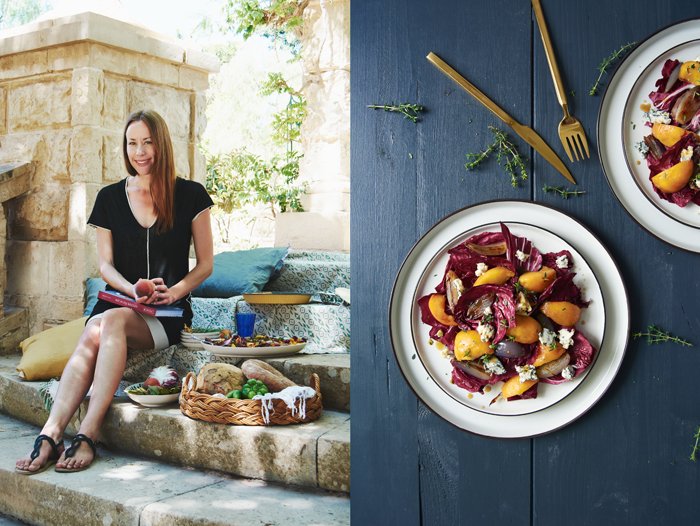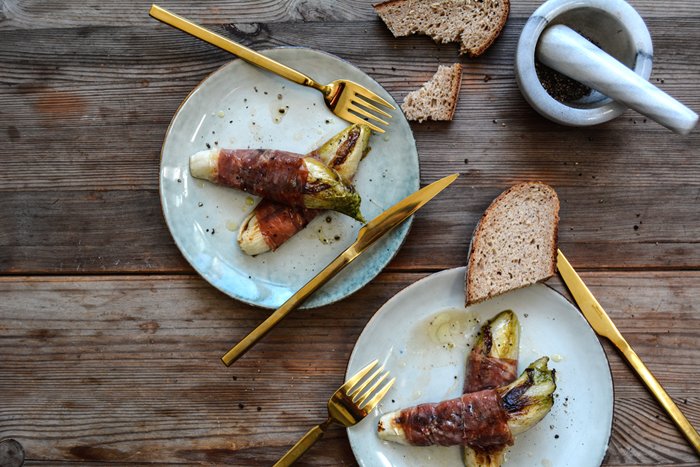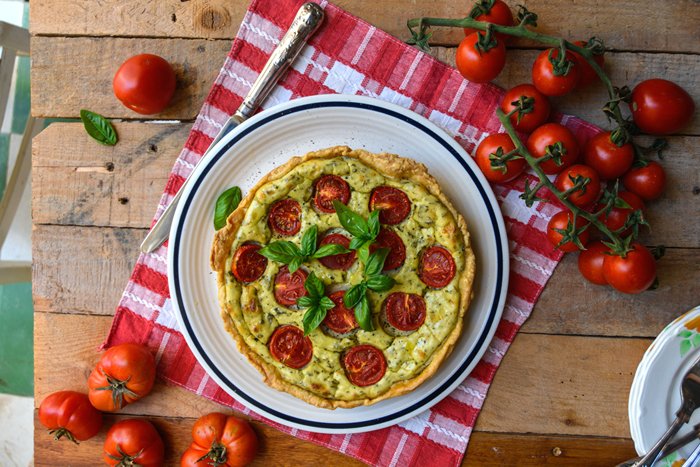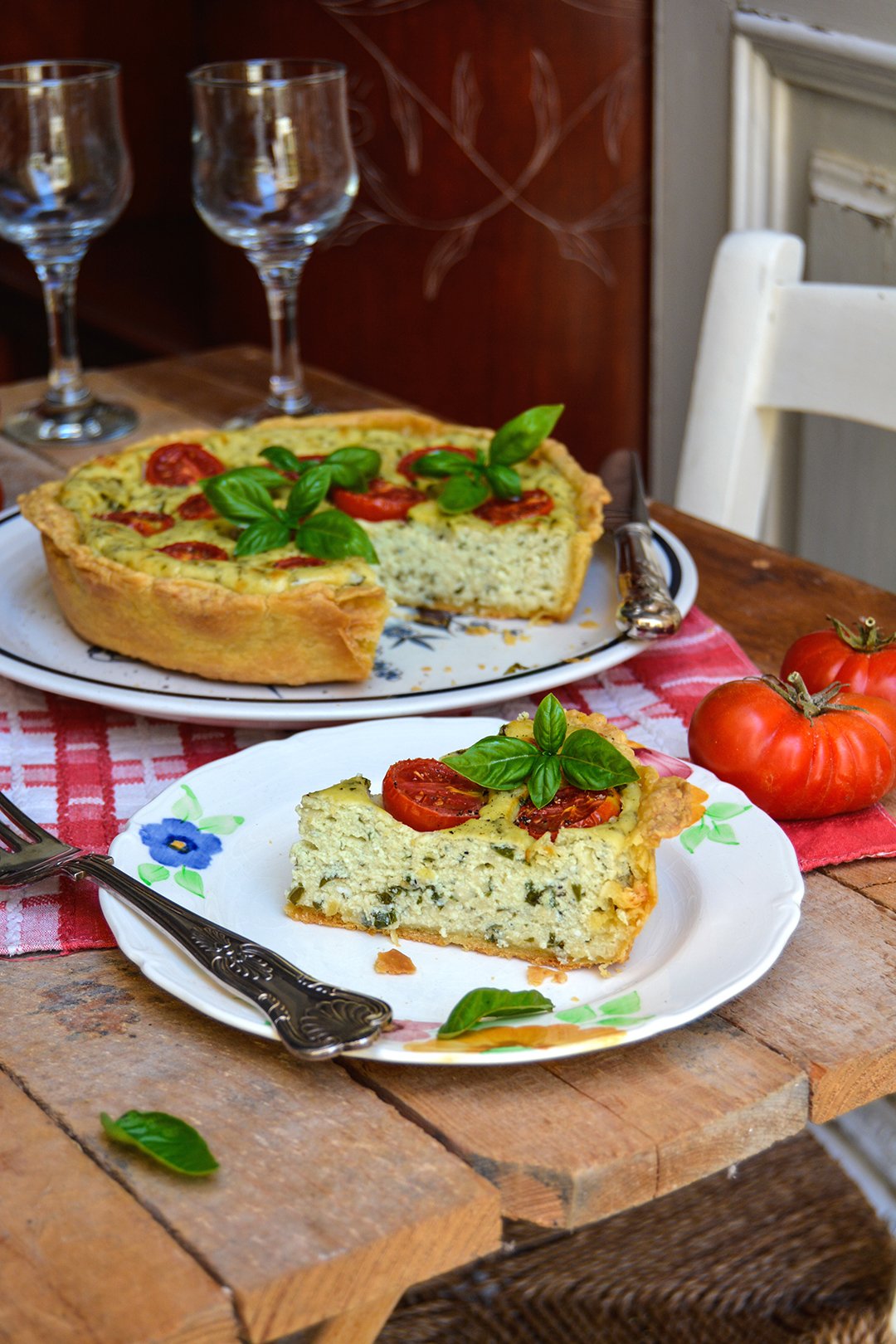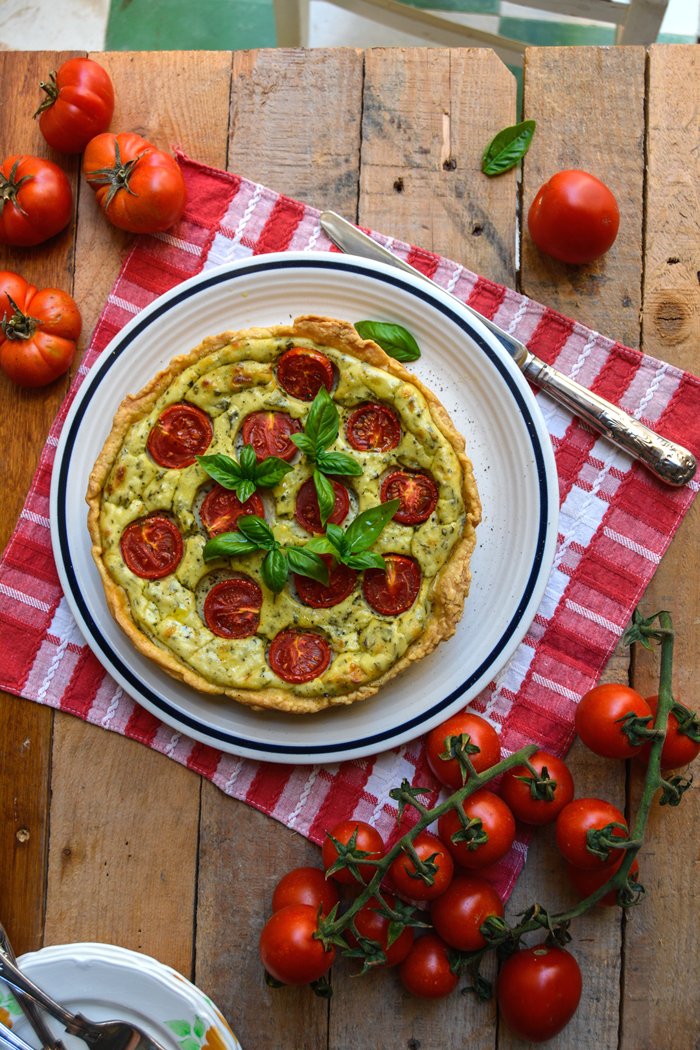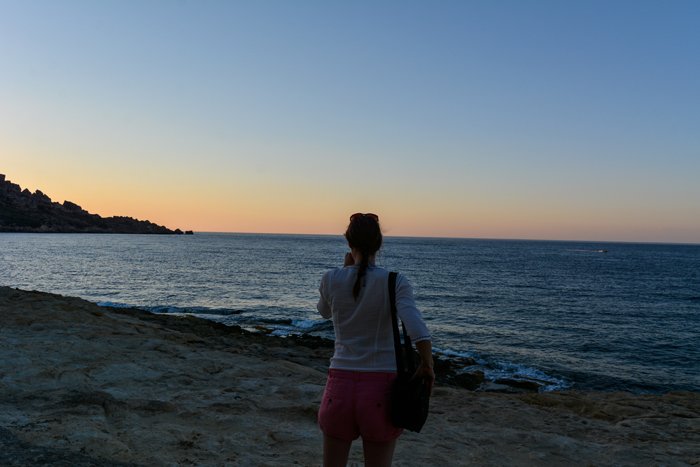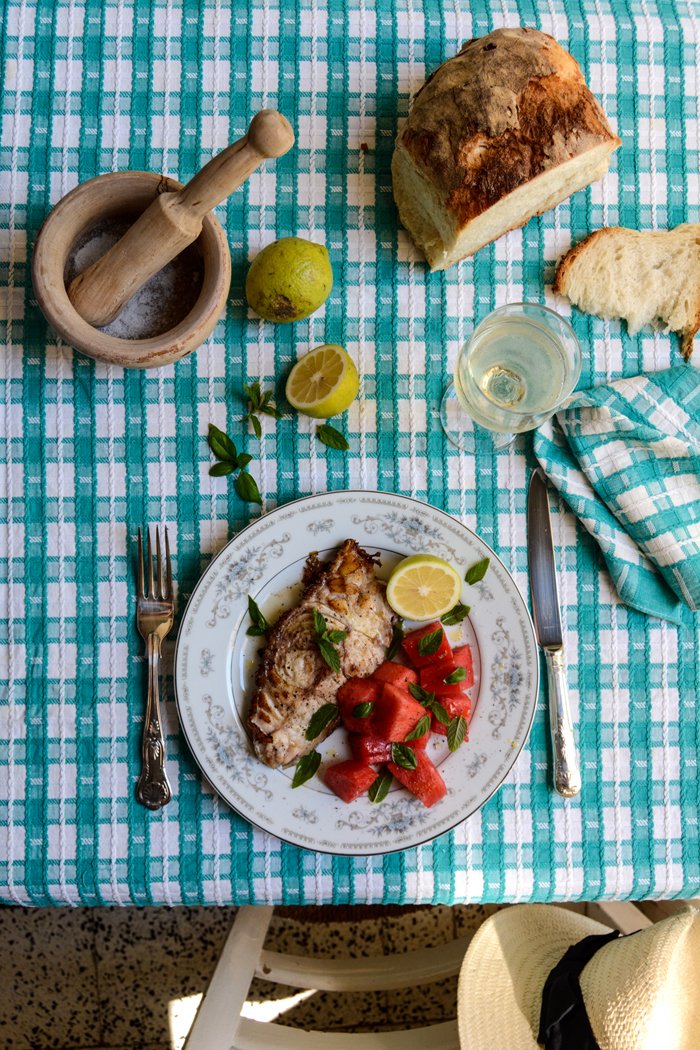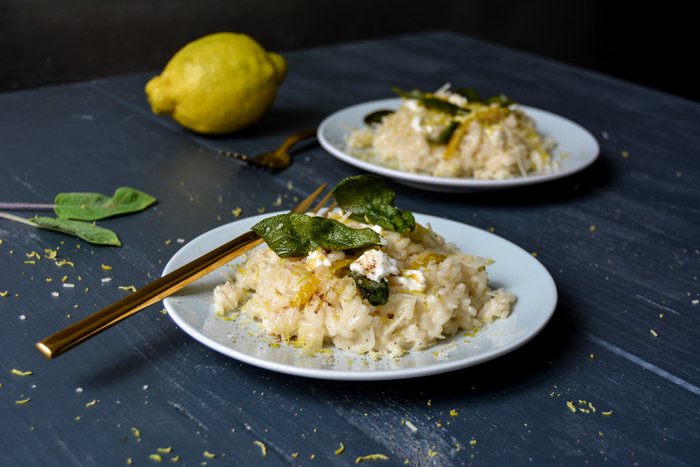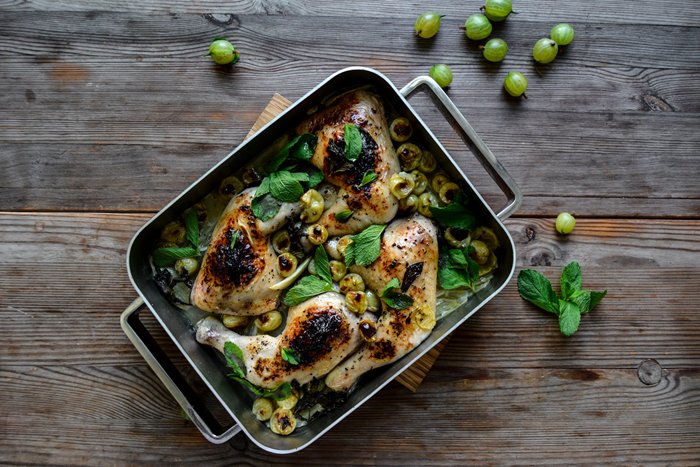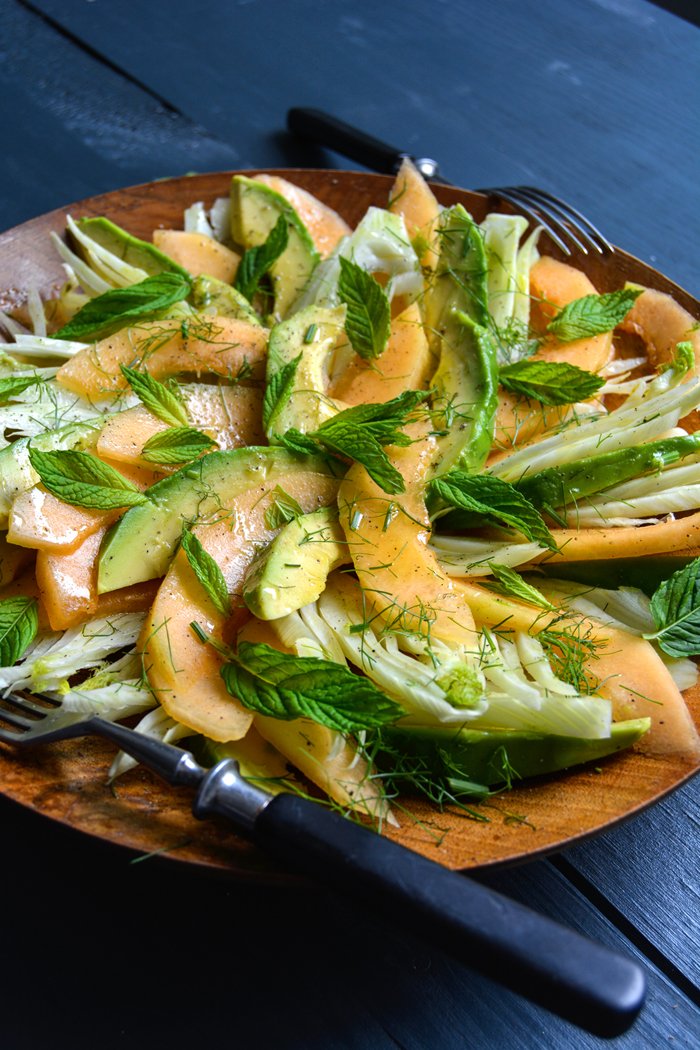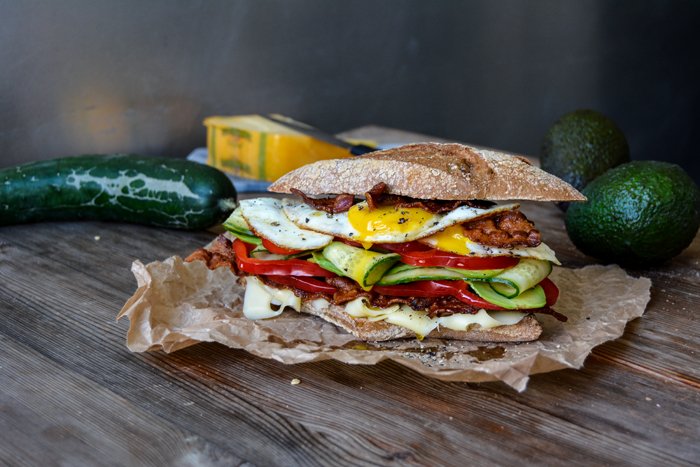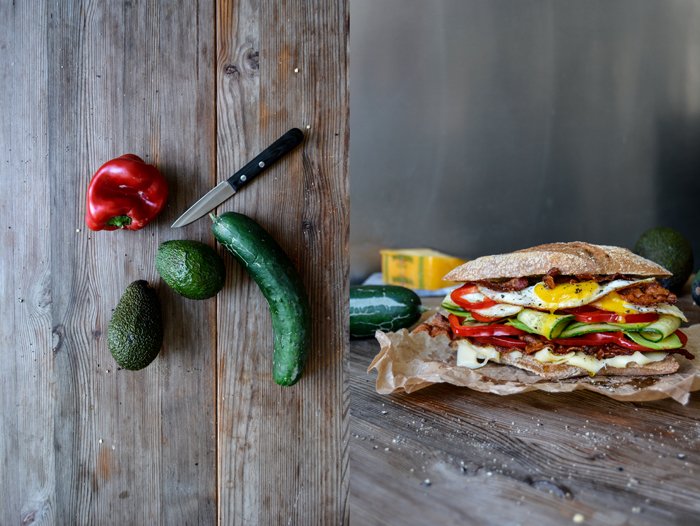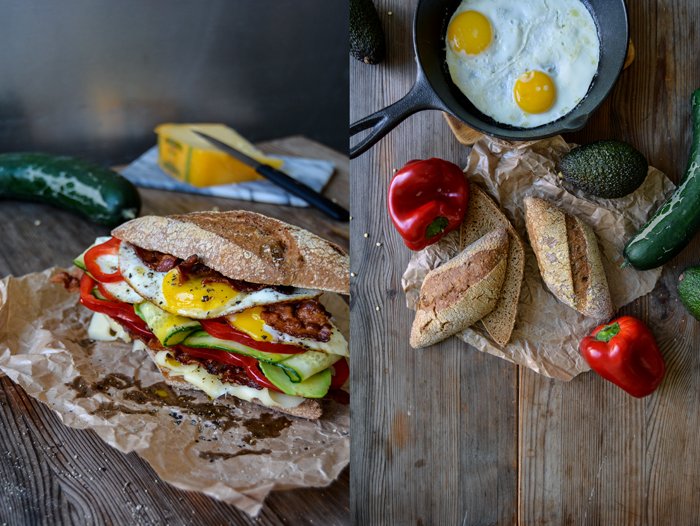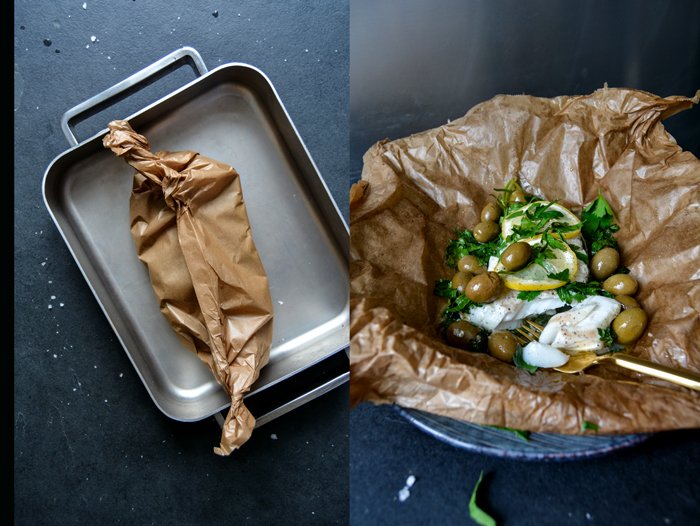Artichoke, Ricotta and Orange Ravioli
If you decide to make your own homemade pasta, be prepared that you'll never be able to eat store bought pasta again (you'll feel less satisfied with it at the very least) - and that you won't feel your arms and abs for a couple days. To knead the dough by hand is necessary and labor-intensive. I had moments when I felt slight doubts about whether the crumbly mixture in front of me would ever turn into a smooth ball, but it worked. I needed all my patience and muscle power to get there, but the result tasted so good that I'd do it all over again (after my muscles got some rest).
My pasta project started last Friday and ended on Saturday afternoon. I first tried a recipe by Sicilian chef Dario Cammarata who only uses plain flour, durum wheat semolina, salt, egg yolks, and olive oil. The result tasted amazing, but getting there was so much harder than what I remembered from when I visited the chef in his kitchen in Frankfurt earlier this year. What seemed so easy in Darios's hands, didn't want to work as smoothly in my own.
Dario taught me that ravioli are best when they are made with egg yolks and not whole eggs. I have no doubt that this is true, the texture is light and perfectly al dente. But to knead my own dough made of 10 egg yolks, flour, and semolina almost made me cry. The mixture was so hard and fragile, I needed an alternative that was less stressful. I still used my egg yolk dough to make a few ravioli, which were perfect, and I made tagliatelle. And these were the best tagliatelle of my life - taste, texture, and thickness were spot on!
Early the next morning I went back to my kitchen. More eggs in the bowl (this time including the egg whites), with a fresh and open mind and a quenchless appetite for fresh pasta, I felt optimistic. Kneading the dough still required some serious muscle power (maybe it's just me, my arms are not the strongest), but it was manageable. And this time I totally enjoyed pulling the thin layers of fresh pasta through my KitchenAid pasta attachment. I needed about two test sheets, but then I was in business. They were so thin that I could see my hand through them.
For my first homemade ravioli, I chose a filling that still allowed me to enjoy the fine taste of the egg pasta. After all this work it didn't feel right to knock it out. The combination of preserved artichokes and fresh ricotta refined with a little orange zest was just right, present, but not overpowering. I served it with melted butter and golden artichoke hearts, briefly seared in the sizzling fat. A little crushed pepper and some more orange zest, and my work was done.
My KitchenAid has three pasta attachments and I'm particularly fond of the tagliatelle cutter. Once I was done with the ravioli, all the shorter pieces and leftover dough went through this attachment and they were perfectly cut into the thinest, tastiest pasta. Cook it al dente and add a knob of butter, freshly grated aromatic hard cheese, and black pepper, and you'll have the best meal ever. Buon appetito!
Artichoke, Ricotta and Orange Ravioli
Homemade ravioli are time and labour-intensive. They are a great starter or main dish for a dinner party, but I recommend preparing them a day in advance to keep it stress free. Freeze them (uncooked) and cook them in boiling salted water just before serving for 4 minutes. I recommend using a pasta machine for this recipe.
Makes 20-24 ravioli / serves 2-4
For the pasta dough
plain flour 150g / 1 cup plus 2 tablespoons
durum wheat semolina 150g / 5 1/4 ounces
fine sea salt 1/4 teaspoon
large organic eggs 3 plus 1 egg yolk
olive oil 1 tablespoon plus 1 teaspoon
water, cold, 1 tablespoon
For the filling
preserved artichoke hearts, drained and squeezed, 160g / 6 ounces
fresh ricotta 125 g/ 4 1/2 ounces
olive oil 1 tablespoon
freshly grated Parmesan 25g / 1 ounce
a pinch of freshly grated orange zest
fine sea salt
ground pepper
For serving
butter 4 tablespoons
preserved artichoke hearts, drained and cut into 6 pieces each, 2
Parmesan
black peppercorns, crushed
a little orange zest
For the pasta dough, in the bowl of a stand mixer fitted with the dough attachment, combine the flour, semolina, and salt. Add the eggs, egg yolk, and olive oil and knead for about 5 minutes (I set it on '4' on my KitchenAid). If it's too dry, add 1 tablespoon of water, but not more. If it's too sticky, add a little semolina and flour. On the counter top or on a stable table, using your hands, continue kneading the dough for about 15 minutes until smooth. It will still be firm. I find it easiest to leave it in the shape of a thick disc for the first 5-7 minutes, punching and kneading it, and scraping the crumbs together. Then I knead it and roll it into a ball (see pictures below). Form a ball, wrap it in cling film, and let it rest in the fridge for 1 hour.
For the filling, purée the artichoke hearts, add to a bowl along with the ricotta, olive oil, Parmesan, orange zest, salt, and pepper. Whisk until smooth and adjust seasoning.
Divide the dough into 4-8 portions (depending on the width and power of your pasta machine). Roll out 1 portion with a rolling pin until it's thin enough to fit into your pasta machine. I started using position '1' on my pasta attachment, using the speed setting '2'. Pull the dough through the pasta machine twice, fold it in the middle, flatten it a little with the rolling pin if necessary, turn it 90°, and pull it through the pasta machine. Continue 2-3 times. Change to a thinner setting (I used '3') and pull the dough through the machine about 3 times, without folding it. Using a knife, straighten the sides of your pasta sheet and cut off excess dough. Continue using the thinner settings of your pasta machine until you can see your hand through the dough (I used '5' and then '6' at the end). If the dough is too sticky, use semolina, but no flour.
Sprinkle the rolled out pasta layer with semolina, fold it gently, and cover with cling film. Continue rolling the remaining dough.
Sprinkle a large baking sheet with semolina. Bring a large pot of generously salted water to the boil.
Lay out a layer of pasta and mark it with circles, using a 7cm / 3" round cutter (or whatever size and shape you prefer). Add a teaspoon of the filling in the middle of each marked circle. Dip your finger in water and wet the rim of the circles. From a second sheet of pasta, cut out circles of the same size, lay on top of the filling, and using your finger, push around the rim (see picture above). Using the cookie cutter, cut out the ravioli and press a little fork all around to seal the rim (see picture below). Transfer the ravioli to the prepared baking sheet.
In batches, cook the ravioli in the simmering water for about 2-3 minutes or until al dente.
To serve the ravioli, in a saucepan, heat the butter over high heat until golden brown, add the artichoke hearts, turn gently, and sauté for 1 minute.
Serve the ravioli sprinkled with the butter, Parmesan, orange zest (optional), and crushed pepper and lay the sautéed artichokes on top.
Pear and Blue Cheese Tart from my cookbook and a picnic in Valletta
Malta, October 2016:
The sky was blue and October's sun still hot, it was a glorious Saturday morning when I met my friends in Msida. The air was filled with the usual chatting and laughing before we hopped into our cars to drive up to Valletta. We brought along the obligatory guitar and our picnic baskets packed with sandwiches, fruits, and a buttery pear and Stilton tart sprinkled with rosemary - a popular recipe from my Eat In My Kitchen book. And off we went to Malta's capital.
We had planned this day trip weeks in advance: to have a picnic in Valletta, high up on the bastions opposite The Three Cities, to park Michelangelo's beautiful Volkswagen beetle in the shade of one of the old olive trees, and set up a little table right next to this cute blue beauty on wheels. It was a luscious brunch in the most stunning surroundings and to bake a savory tart was the best choice for this occasion. You can prepare it in advance, it's delicious even when it's cold, and it fits perfectly to chilled sparkling wine. The topping is minimal, but the combination of baked pear, melted Stilton, and roasted rosemary is so good that it became one of my favorite recipes this year. The creation almost didn't make it into my book. I had a different tart in mind but I couldn't find a certain vegetable on the day of the shoot and spontaneously decided that I could also just fill the pastry with fruit, cheese, and herbs. It was a wise choice that I don't regret.
The setting was as spectacular as our nibbles. If you ever visit Valletta, you have to go to the St. Barbara Bastion and enjoy the breathtaking view overlooking the Grand Harbour and The Three Cities, Vittoriosa, Cospicua and Senglea. Then walk down to the Valletta Waterfront and take one of the little ferries to Cospicua. It only takes a few minutes and it allows you to enjoy two of the most stunning places in Malta, on land and from the sea: the golden beauty Valletta and the three fortified cities.
Pear and Blue Cheese Tart with Rosemary
From my first cookbook, Eat In My Kitchen
Serves 4 to 8
For the pastry
2 cups (260 g) all-purpose flour
1 teaspoon fine sea salt
½ cup plus 1 tablespoon (130 g) unsalted butter, cold
1 large egg
For the topping
2 large, firm pears, cut into thin wedges
3 ounces (85 g) aromatic blue cheese, such as Stilton, Roquefort, Fourme d'Ambert or Gorgonzola, crumbled
3 medium sprigs fresh rosemary, needles only
3 tablespoons olive oil
Flaky sea salt
A few black peppercorns, crushed with a mortar and pestle
For the pastry, combine the flour and salt in a large bowl. Add the butter and use a knife to cut it into the flour until there are just small pieces left. Quickly rub the butter into the flour with your fingers until combined. Add the egg and mix with the dough hooks of an electric mixer until crumbly. Form the dough into a thick disc, wrap it in plastic wrap, and freeze for 10 minutes.
Preheat the oven to 400°F (200°C).
On a table or countertop, place the dough between 2 sheets of plastic wrap and use a rolling pin to roll out into a disc, large enough to line the bottom and sides of a 12-inch (30 cm) quiche dish. Fit the dough into the quiche dish, pushing it into the dish, especially along the edges. Let the dough hang over the rim a little or cut it off with a knife. Use a fork to prick the dough all over. Bake for 15 to 18 minutes or until golden. If the dough bubbles up, push it down with a fork. (If you blind bake the pastry under parchment paper and dried legumes, remove the paper and legumes after 15 minutes and bake uncovered for a few more minutes until golden.)
Arrange the pear wedges in overlapping circles on top of the warm, pre-baked pastry, sprinkle with the cheese and most of the rosemary, drizzle with the olive oil, and season to taste with flaky sea salt and crushed peppercorns. Bake for 15 minutes or until the cheese has melted and the pastry is crisp. Sprinkle with the remaining rosemary and enjoy warm or cold.
7 Meat & Roast recipes to indulge in on Thanksgiving
A meal at a festive table, in the dimmed light of flickering candles, all our loved ones around us, is always a gift, it's a feast of love and sharing. These are very precious memories of our lives, we'll never forget the food we smelled and tasted, the grateful happiness in the eyes of our family and friends, the room filled with music and laughter.
Let's talk about meat and roast recipes to make our Thanksgiving table complete and accompany my 10 pumpkin recipes that I shared with you a couple days ago. I love my juicy Roast Rosemary Lamb or the tender Thyme and Lemon Ricotta stuffed Pork Roll. You can also find a recipe for a delicious German pork roast with crackling in my cookbook, on page 163. Slow roasted duck, preferably cooked together with fruit, will always find a special place in my heart, the meat is so tasty and tender, the skin crisp, it's definitely one of my favourites for a special feast at the table.
Besides the classic roasts, there are other scrumptious recipes that I could indulge in with the greatest pleasure, also on Thanksgiving: Coq au Vin, tiny Lamb Chops with Orange and Herb Crust, or Spice Roast Chicken Legs with Butter Beans.
Click on the titles for the recipes
Roast Chicken with spiced Peaches: (you can replace the peaches with plums)
10 Pumpkin recipes to inspire your Thanksgiving table
Thanksgiving calls for pumpkin on the table, lots of pumpkin! Since winter squash is so versatile, I wouldn't mind having a festive meal dedicated to these gorgeous beauties in orange, green, and golden yellow. Nibbles, soup, main, and dessert - I'd be up for a pumpkin celebration.
When it comes to the main course, we have two options, we can either go vegetarian and in this case I strongly recommend the Pumpkin Crespelle with Ricotta and Sage - although the Pumpkin Gnocchi wouldn't be a bad choice either. However, if you need some meat on your plate, I'll share my suggestions with you tomorrow. But we can already start thinking about the sides and there's a universe of options. Gnocchi always work, there's no doubt that their spongy softness is perfect to soak up the juices of a roast, or you can go for maple orange pumpkin with sage and walnuts from my tartine recipe below (without the bread); pumpkin, stilton, and rosemary is also a very pleasant combination (taken from another sandwich recipe below). Roast it, cook it, sauté the squash - thinly sliced - in a pan (like in the Hokkaido Pumpkin Spaghetti), or bake a soufflé. If you want to keep the crowd entertained while you're cooking, serve the Pumpkin Pesto, Date, and Chèvre Sandwich and everybody will be happy.
Click on the titles for the recipes
Spinach and Chèvre Sandwich & my London book launch at the Maltese embassy
Malta, Berlin, London - three countries in less than 24 hours! The pace of my traveling fit the mood, vibrant and exciting, I didn't want to rest. I arrived in England at noon, had at a scrumptious lunch at Ottolenghi Spitalfields and a chat with chef Sami Tamimi. To charge my batteries, I finished my meal with a double espresso and a luscious piece of Guinness chocolate cake with Bailey's frosting. London looked bright and sunny as I stepped out onto the streets and I felt ready for my third book launch event, on the roof terrace of the High Commission of Malta in the English capital.
To make my travels feel even sweeter, I got to stay at the luxuriously relaxing Corinthia Hotel London. Right between St. James's Park and the Thames, the location couldn't have been better. I could walk to my event at the Maltese embassy and to my book signing at the Tate bookstore the next day. Before the festivities started, I had enough time to enjoy the amenities and comfort of the house, and especially the most beautiful marble bathroom I ever happened to see. It was marble heaven and I felt like a princess as I dressed up for my big night.
Unfortunately, the pretty lace dress that I had bought for this festive occasion didn't really fit London's weather conditions - it was freezing cold as I opened the door to the terrace of the High Commission of Malta. I wrapped myself in a warm coat most of the time, which I only took off quickly for the photographers and an interview. The jump in temperature between summery Malta and England's rather rough climate was too painful. However, the stunning view over roof tops, church spires, and The London Eye made all of us forget about the weather. We just stood there, high up under the Maltese flag, astonished by London's beautiful sunset, dramatically framed by the darkest clouds. We were lucky, not a single drop of rain fell onto the delicious looking buffet prepared by Kitty Coles (thank you so much, my dear) or into our glasses, filled with Meridiana's finest wines, poured by my book tour mate and Meridiana's best man, Karl Chetcuti.
I have to thank a few very special people who made this unforgettable night happen: His Excellency Norman Hamilton, High Commissioner of Malta, Nerissa Sultana, Political and Communications Officer, and their fantastic team at the embassy. Thank you for sharing the High Commission's roof terrace with us, thank you for all your help and support, for all the time to exchange ideas for this event. Thank you Emma Cook from Prestel for helping me organize this special evening.
The speeches of the High Commissioner and of Andrew Hansen, Managing Director of Prestel Publishing London, both touched my heart, and then it was my turn to welcome our guests. It was too dark and windy to follow our manuscripts, our microphone decided to stop working, but that didn't do our celebrations any harm. It felt like a scene from Peter Pan, high up over London's roof tops, the air filled with laughter, glasses filled with good wine, and lots of delicious food on our plates. But unlike the book or movie, we didn't need our imagination, it was all real.
Before we drove back to the airport, we enjoyed a sandwich that was so good that I decided to re-create it at home and share it with you: spinach and ripe chèvre in carrozza (meaning in a carriage). This sandwich is similar to french toast, however, it's a savoury treat, lusciously filled and hearty. The combination of winter greens and ripe cheese was fantastic. I have an in carrozza sandwich recipe in my book, which I adore, but there are so many ways to fill two slices of bread!
Thank you London! xx
At the event, I was interviewed by Rita for her Share Food with Sainsbury's Magazine radio show, you can listen to our chat here. To see all the pictures of the event in London taken by the amazing photographer Agnese Sanvito, click here. And here are the pictures of our book signing tour at Tate, Waterstones, and Foleys.
All the pictures of the launch are by Agnese Sanvito.
Spinach and Chèvre Sandwich
Makes 2 sandwiches
spinach leaves, a large handful, about 140g / 5 ounces
fine sea salt
ground pepper
freshly grated nutmeg
ripe chèvre, about 60g / 2 ounces
organic eggs 2 (mine were quite small)
milk 3 tablespoons
plain flour 2 to 3 tablespoons
soft white bread 4 slices
butter, about 1 tablespoon
black peppercorns, crushed in a mortar
In a large pot, bring salted water to the boil and blanch the spinach for 1 minute. Rinse with cold water, drain, and let cool for a few minutes. Using your hands, squeeze out most of the liquid and chop roughly. On a large plate, crumble the spinach and season with salt, pepper, and nutmeg to taste.
Cut the chèvre into thin slices, leave out 4 slices for the topping, and crumble the remaining cheese over the spinach.
In a shallow bowl, whisk together the eggs and milk. Season to taste with salt and pepper. Spread the flour on a flat plate.
Divide the spinach-chèvre mixture between 2 slices of bread, leaving a thin border around the edges. Top each with a second slice of bread and press the sandwiches together. Dip both sides of each sandwich in the flour until lightly coated. Carefully dip each sandwich in the egg-milk mixture, repeat until all the liquid is soaked up—mind that the filling stays inside.
In a large, heavy pan, heat the butter over medium heat and cook the sandwiches, turning and pressing down on them gently with a spatula, for a few minutes or until crisp and golden brown. Lay the remaining chèvre slices on top of the warm sandwiches and sprinkle with crushed pepper. Cut the sandwiches in half and serve immediately.
Camping deluxe - Farfalle Pasta with Figs, Mozzarella di Bufala & Honey Butter
Although I can't really call myself an experienced camper, I'm fascinated by the idea of setting up a tent in the middle of nowhere and keeping the signs of civilization to a minimum.
I got my introduction to camping through my boyfriend. To avoid unnecessary difficulties, he chose wisely and decided to give it a go when we were in his home country - a place where you're never really completely cut off. He convinced me to take a boat to Comino, Malta's tiny sister island, which is just the right size to jump bravely into our first outdoor adventure without having to worry about too many risks. Our 'captain' dropped us off at the shore, along with our two bags, a tent, and a cooling box. It was August, it was unbearably hot, and I found myself in the middle of the Mediterranean Sea, on a rocky island. There was not a single tree in sight. My boyfriend, however, looked at the situation with far more optimism. He knows Comino like his back pocket, thanks to countless trips as a child. He set up our rather basic looking tent within less than 10 minutes, with a little help from his clueless German girlfriend (I really tried hard not to be a burden). And when we were done, we jumped into the gentle waves in a lonely bay and I felt a bit like Robinson Crusoe. All of a sudden I started to like this camping idea.
To prepare our dinner, I collected some twigs and my man made a fire. We even managed to exchange a few of our tomatoes from the cooling box with the fresh catch of a passing fisherman. Then I got comfortable: I couldn't help but turn the rocks around me into a little desert island kitchen. Olive oil, salt, and pepper were ready to marinate the fish and vegetables for our DIY BBQ and we sat down with a glass of wine (a gift from the fisherman). This dinner tasted so good that I could have cried. Maybe that's part of the whole camping experience, you're very close to nature, you depend on the weather, the sunlight, the sea, and the food that nature (or your cooling box) offers you. It makes you humble and it opens your senses, everything feels more intense. To smell, taste, feel, and see is essential when you live in and around a tent or camper van. The night came early and covered our little island in the deepest darkness. As soon as the sun sank into the sea, I felt more sleepy than usual, but also more peaceful. I brushed my teeth in the calm sea and went to bed.
Most of my activities on the Maltese Islands are documented in thousands of pictures, but the idea of camping - at least in my eyes - is about being unplugged and as far away from any technical devices as possible. So there's no photographic evidence of my first or our following Comino camping adventures. However, when I spoke to my mother about camping recently, she brought many stories and pictures back to mind that I hadn't thought of in decades. My parents and my sister went to the Camargue, in southern France in the 70s, to a place with the beautiful name Saintes-Maries-de-la-Mer. They didn't have a tent but an old Volkswagen van. I always loved the old photographs, of them on the beach and in old villages, on ancient narrow cobblestone streets. The ease of a camper on their faces. One of the nicest camper vans I know belongs to our friends Luke and Jessica in Malta. Their gorgeous four wheeled gem is baby blue, built in 1968, and its restoration took them 10 months, but all the patience, sweat, and love they put into it was worth it.
Stephanie Le from Canada also shared her love for camping with me in our meet in your kitchen feature a few weeks ago. She's a pro, she even manages to create a Beef Stroganoff when she's out in the woods. Stephanie made me think about the culinary challenges that you have to face when you limit your life to a few bags and a grill or gas stove. It also makes a huge difference if you're in a place that still allows you to forage, or where fishermen offer you the best fish you ever tasted in your whole life. I'm talking about a rather romantic kind of camping here, away from the crowds and civilization and its disturbing visual and acoustic side effects.
Let's say you'll be out in the wilderness, for 1-2 nights, and you can upgrade your meal with some fruit and dairy products, the cooling box will keep it fresh for a day. When Volkswagen asked me to come up with a recipe - an eat in my kitchen on the road creation - I couldn't help but think of camping deluxe. A kind of camping that satisfies the longings of a gourmet who ended up off the beaten track. The senses stimulated by the whole outdoor experience, ready to be caressed by a beautiful plate of farfalle with ripe figs, creamy mozzarella di bufala, velvety honey butter, and fragrant basil. The dried pasta and honey are easy to store, the figs and herbs can be kept in a lunch box, and the mozzarella and butter stay fresh in the cooling box. This would be my ideal treat for a night under the clear black sky.
For more delicious recipes and kitchen inspiration, visit Volkswagen's Pinterest community board Food Blogger for Volkswagen.
Farfalle Pasta with Figs, Mozzarella di Bufala and Honey Butter
Serves 2
farfalle pasta 200g / 7 ounces
butter 3 tablespoons
honey 1 1/2-2 teaspoons
large figs, cut into 8 wedges each, 2
mozzarella di bufala, torn into pieces, 125g / 4 1/2 ounces
fresh basil leaves, a small handful
black peppercorns, crushed in a mortar
flaky sea salt
Cook the farfalle in salted water until al dente.
In the pot used to cook the pasta, heat the butter and honey and whisk until combined. Mix in the farfalle, stir, and divide between 2 plates. Arrange the figs, mozzarella, and basil on top and season with crushed pepper and flaky sea salt to taste.
Enjoy warm or cold.
Eat In My Kitchen is out! From the book: Radicchio, Peach & Shallot with Stilton
The Eat In My Kitchen book is out and I'm the happiest person on the planet!
One of the exciting - and often quite challenging - things in life is that you never really know where the journey will take you. It's like being on a ship out on the open sea. Sometimes it seems like you can control the direction, but it might just be an illusion, and in the end you can only ever go with flow instead of fighting against it. Since I understood this, my life rolls more smoothly than ever. I wasn't one of those kids that had a clear idea of their future and what it should bring. At the age of 18 I was still a bit clueless about my place in this world, so I decided to go to university and study architecture. I was a good girl and left 4 years later with a diploma in my pocket although I knew I wouldn't want to work as an architect. Instead, I worked happily in the music industry for 15 years. But things changed, I changed, the music business changed, my direction in life changed. I decided to start a food blog on a cold winter's day in November 2013, and this decision had more of an impact on my life than I could have imagined back then. I shared a new recipe every day in the first year of Eat In My Kitchen, and although I felt creatively extremely stimulated after those 12 months, I was also exhausted. My writing and photography improved tremendously in that year, and my cooking and baking evolved as well - I became more experimental. However, I had to slow down the pace, it was too much. But the solution was easy: less posts on the blog and I found a rhythm that allowed me to enjoy every single part of being a blogger (it still feels weird to say that).
In the even colder days of February 2015, life, the universe, destiny, luck, or whatever you may call it, had different plans. Holly La Due from Prestel Publishing in New York came into my life, she sent me an email in the morning, we skyped in the afternoon, and sealed our deal in the evening - all in one day. Holly's decision to ask me if I'd like to write a cookbook, changed my life so drastically that I'm still processing what's been happening in the past year and a half. I never really got used to seeing myself as a blogger, life was too fast, and now I'm a cookbook author. I still have these moments, when I look at my book using one of the recipes in my own kitchen, and I get a little shock and feel, "wow, that's my book". I guess I need a little more time.
Most of the time in life it's not just us alone, not just a single person who creates, we're woven into a net of people, ideas, and visions. Whoever pulls the string on one side of the net, affects the whole result. This heavy blue book full of recipes, Eat In My Kitchen - to cook, to bake, to eat, and to treat, is not just lying on my table anymore, today it's been sent out into the world, now it's on the book shelves and maybe lying on your table. And this makes me feel peacefully happy and thankful, I could squeeze the world.
This book has been a gift for me from the start. Being able to turn a vision into a physical object makes me feel very humble, I know that this book carries a part of every single person who's been involved. Thank you, to the most amazing team and friends all over the world:
Holly, Jamie, Jan, Lauren, Karen, Luke, Stephen, Angy, Emma, Oliver, Andrew, Will, Marisa, Ron, Monica, Ellen S, Jen, Pia, Julie, Adeline, Ellen M, Cynthia, Molly, Malin, Yossy, the Cini family, Jasmine and Melissa Hemsley, Joanna, Karl, Jo, Iggy, Marina, Türkan, Jörg, Kitty, Hetty, Mama, Uli, Ursula, Uwe, Jenny, Edith, Emma, Alex, Julia, Nina, Kim, Jessica, Luke, Matt, Muxu, Daphne, Nadine, Jan, Essa, Sandra, Chris, Alexandra, Doris, Chris, Anna, Jimmy, Gina, Pattie, Jayne, and all my loved ones.
Thank you my wonderful food loving blog friends, you've come back and visited these pages for almost 3 years. Your passion, enthusiasm, your questions and comments, your emails and pictures, made me enjoy my kitchen and my food even more than I already do. You drive me on to dig deeper into culinary traditions and to come up with new ideas every day. Thank you and a big hug!
Today I'll share the second recipe from my book with you, the colourful salad that made it onto the cover of my book and that became one of my favourites. It's a luscious composition playing with contrasts: bitter crunchy radicchio, soft and juicy peaches, sweet oven roasted shallots, sharp Stilton, and a little thyme. It's a beauty on your picnic blanket, a fresh addition to your brunch table, and the easiest starter for a dinner party.
The pictures of me and the picnic scene in this post were taken in July, at Villa Bologna in Malta, for an article in Eating & Drinking Magazine.
Radicchio, Peach, and Roasted Shallot Salad with Blue Cheese
SERVES 2 TO 4
FOR THE SALAD
8 shallots, peeled and cut in half lengthwise (or 4 small red onions, peeled and cut into quarters)
2 tablespoons olive oil
Flaky sea salt
Ground pepper
5 ounces (140 g) radicchio, soft leaves only, torn into pieces
4 ripe peaches, peeled and cut into 8 wedges each
2 ounces (60 g) Fourme d’Ambert, Stilton, or any crumbly blue cheese, crumbled
1 to 2 tablespoons fresh thyme leaves
FOR THE DRESSING
3 tablespoons olive oil
1 tablespoon balsamic vinegar
1 tablespoon white balsamic vinegar
1 teaspoon honey
Fine sea salt
Ground pepper
Preheat the oven to 425°F (220°C) and line a baking sheet with parchment paper.
Spread the shallots on the lined baking sheet, drizzle with the olive oil, and season to taste with flaky sea salt and pepper. Gently mix with your fingers and roast for 10 minutes. Flip the shallots over and roast for another 5 minutes or until golden brown and soft. Peel any hard or burnt layers off the shallots and set them aside. You can prepare the shallots in advance; they don’t need to be warm.
For the dressing, whisk together the olive oil, both vinegars, and the honey; season to taste with salt and pepper.
Arrange the radicchio, peaches, and shallots in overlapping layers on plates, sprinkle with the crumbled cheese and thyme, drizzle with the dressing, and serve immediately.
Beluga Lentil Burger with Mozzarella, Pomegranate and Dukkah
My late summer of 2016 feels like an emotional roller coaster. And when there's too much work to be done it's so easy to panic, to be overwhelmed or to just give up. But I believe that we don't give up because there are wonderful people around all of us who catch us when we fall.
Many people catch me at the moment, some must already have sore arms and I can't thank them enough for being there for me and going through this rather intense time together with me. They listen to a crazy woman whose first cookbook will come out soon, in just a few days, and whose ups and downs can be more than tiring. They listen to me, they cook for me, they calm me down, and make me laugh. Many of them have been in my life for years and years, some I've only met a few days, weeks, or months ago. This post is for all these amazing people around me, thank you!
When I needed a spontaneous translation of a press release from English to Maltese a few days ago, I could count on my dear friend Jessica who even worked on it during a camping trip on the weekend. And Nikola, who I never even met before, made it possible to proof read it within a couple hours after I got in touch. My boyfriend is my rock, there wouldn't be this book without him, and Eat In My Kitchen wouldn't be as inspired as it is - my man is the biggest joy one can possibly have in life. The other day I was looking for accommodation in New York and someone who I haven't even met before helped me out without hesitation. And when I was chatting with Hetty McKinnon from Arthur's Street Kitchen about a meet in your kitchen feature this week, I mentioned that I'm planning my book launch event in NY at the moment and that I was struggling. It's a bit tricky when you're on another continent, everything takes much longer. Within a split second, Hetty offered to cook my recipes for my book launch event in Manhattan. I could go on and on, the list of people who've helped and supported me is long and I know it will become longer and longer in the next few weeks.
We're not alone, and that's wonderful, there are times to help others and there are times to receive help from the people around us. We should never forget that we're not alone.
I dedicate this recipe to everyone who has helped me, to my friends, my family, and everybody who I met and will meet on this journey and who makes it even better. It's a recipe that combines different tastes and textures: nutty Beluga lentil burgers and creamy mozzarella di bufala sprinkled with fragrant dukkah spice and nut mixture and juicy pomegranate. It's as vibrant, rich, and colourful as we all are. You can turn it into a sandwich, as I did, but that's not even necessary.
A big hug to all you wonderful people around me! xx
Beluga Lentil Burger with Mozzarella, Pomegranate and Dukkah
Makes 2 sandwiches
For the dukkah
30 g (1 ounce) skin-on hazelnuts
30 g (1 ounce) salted pistachios
30 g (1 ounce) white sesame seeds
30 g (1 ounce) sunflower seeds
1 teaspoon fennel seeds, crushed with a mortar and pestle
1 teaspoon coriander seeds, crushed with a mortar and pestle
1/2 teaspoon black peppercorns, crushed with a mortar and pestle
1/2 teaspoon coarse sea salt
1/4 teaspoon ground cumin
For the lentil burgers
1 bay leaf
2 small sprigs fresh lemon thyme
60 g (2 ounces) beluga lentils (no soaking required)
40 g (1 1/2 ounces) drained canned cannellini beans, rinsed and roughly mashed with a fork
1 spring onion (green part only), thinly sliced
1 small clove garlic, crushed
1 large egg
40 g (1 1/2 ounces) Parmesan, finely grated
20 g (2 tablespoons) dry breadcrumbs
1 teaspoon freshly grated lemon zest
1/2 teaspoon fine sea salt
ground pepper
olive oil, to cook the burgers
For the sandwiches
2 rustic white buns, cut in half
4 lettuce leaves125 g (4 1/2 ounces) mozzarella di bufala, torn into small pieces
olive oil
1/2 pomegranate
1-2 teaspoons freshly grated lemon zest
You won't need all of the dukkah for this recipe. Store leftover dukkah in an airtight container and use it in salads and soups.
For the dukkah, pulse the ingredients in a food processor until crumbly—the mixture should be dry—and transfer to a bowl or an airtight jar.
For the lentil burgers: Fill a large pot with water, the bay leaf, and thyme. Add the beluga lentils and bring to the boil. Cook, according to the package instructions, for about 18-20 minutes. The lentils should have some bite. Remove and discard the herbs, drain the lentils, and let cool completely.
Preheat the oven to 200°C (400°F). Line a baking sheet with parchment paper.
In a large bowl, combine the lentils with the beans, 3/4 of the spring onion, the garlic, egg, Parmesan, breadcrumbs, lemon zest, salt, and pepper. Use your hands or a large spoon to mix until well combined. Wet your hands and form the mixture into 6 burgers.
In a large, heavy pan, heat a generous splash of olive oil over medium-high heat. Turn the heat down to medium and cook the burgers, flipping once, for 2 to 3 minutes per side or until golden brown. Transfer to the lined baking sheet and bake for 8 minutes in the oven.
Divide the lettuce leaves, lentil burgers, and mozzarella among the sandwiches and drizzle with olive oil. Sprinkle with the pomegranate seeds, fresh lemon zest, the remaining spring onion, and some dukkah. Close the sandwiches and enjoy!
Spiced Plum and Cheese Omelette Ciabatta Sandwich
The changing of the seasons, the short gap before the next season takes over, is a great gift. It's a time that tends to fill me with great excitement. Autumn's waiting in the wings, yet summer isn't ready to say goodbye. There's no need to rush, I can indulge in Vorfreude - the German word for the happiness and excitement that we feel before a special event. The idea of coziness and comfort food, long walks in the forest and snuggly sofa time is already more than appealing. I replace my flowery dresses with a pair of jeans and a cardigan and spend just as much time outside as I did in the past few months. The sun is lower and wraps the world around me in a gorgeous golden glow, everything looks softer and warmer. My appetite shifts from lighter treats to the richer pleasures of the kitchen, and my mood is full of joy and curiosity for everything that the next couple months will bring into my life.
Cooking plums with spices is a celebration of late summer, but with a subtle nod towards the festive season. I had this aromatic duo in mind when Leerdammer asked me to create a new sandwich, a sandwich that fits my current mood. The fruit caramelized in sugar, cinnamon, and coriander seeds, sits on top of a rich cheese omelette. This whole juicy joy is layered in a soft ciabatta bread, sprinkled with a bit of fresh thyme. Just one bite and I'm ready to celebrate the season. I love to indulge in the produce that every month of the year offers, especially when there's fresh bread on the table: Be it in my Cheese, Bacon, and Egg Sandwich with Garden Vegetables, a summery light creation in June, or the pleasures of zucchini cheese fritters and strawberries piled between two slices of bread. Maybe I should come up with a sandwich calendar one day.
I usually spend late September and October experimenting with roots and winter squash, with grapes, plums, and apples. I try out new meat dishes and enjoy my trusted classics. But this year, I'll 'lose' a month in the kitchen. I'll be traveling through Europe and the US pretty much all of October to launch my book and to finally present my recipes, printed on paper, physically and not just in the digital spheres of the world. As much as I know that I'll miss my kitchen, I can't say that this circumstance fills me with sadness. I'm nervous, excited, even a bit hysterical at times, but I can't wait to finally open the pages of the Eat In My kitchen book and show it to all the people who I'm going to meet soon.
To make up for the kitchen break ahead of me, I spent the past few weeks cooking and baking with all the ingredients that I'll miss out on. Plums are at the top of my list - for sweet and savoury dishes. If I had to choose one flavour to describe this time of the year, it would be plums. I love their sour fruitiness, especially cooked, in combination with aromatic spices. Add them to a bowl of vanilla ice cream and whipped cream and you can still taste summer, turn them into a fragrant chutney and stir them into the thick sauce of a venison stew in a couple months and you're ready for winter. Dumplings, jam, cakes, or sandwiches, there's no recipe that this fruit can't deal with.
This post has been sponsored by Leerdammer.
Spiced Plum and Cheese Omelette Ciabatta Sandwich
Makes 2 Sandwiches
For the caramelized plums
granulated sugar 2 tablespoons
unsalted butter 2 tablespoons
coriander seeds, crushed in a mortar, 1 teaspoon
ground cinnamon 1/2 teaspoon
large plums, cut into quarters, 4
For the omelette
organic eggs 3
heavy cream 60ml / 1/4 cup
freshly grated nutmeg
fine sea salt
ground pepper
butter 1 teaspoon
For the sandwich
lettuce leaves 2-4
small ciabatta bread, cut into 2 buns, each cut in half, 1
Leerdammer cheese, thinly sliced, about 60g / 2 ounces
a few fresh thyme leaves
black peppercorns, crushed in a mortar
For the caramelized plums, in a medium, heavy pan, heat the sugar, butter, and spices over medium high heat, stir, and add the plums as soon as the butter is golden and sizzling. Cook the plums for about 2-3 minutes on each side or until golden and soft. Turn them gently one by one, and mind that they keep their shape. Take the pan off the heat.
For the omelette, whisk the eggs and heavy cream and season with nutmeg, salt, and ground pepper. In a small, heavy or non-stick pan, heat the butter over medium-high heat. Pour the egg mixture into the pan, scramble very lightly and fold onto itself. When the bottom side starts to become golden flip the omelette around. Cook it shortly from the other side for about a minute or until the omelette is just set. Take the pan off the heat and cut the omelette into large chunks.
Arrange the lettuce on top of the two bottoms of the buns. Divide the warm omelette between the buns, spread the cheese on top, then finish it off with the warm caramelized plums. Pour the buttery juices from the pan used for the plums over the fruit and sprinkle with thyme and a little crushed black pepper. Close the bun, squeeze a little - gently! - and enjoy!
Sautéed Belgian Endive wrapped in Prosciutto di Parma
The lack of time can be as fruitful as frugality. My mind tends to work quicker - and come up with surprisingly good ideas - when I don't have time and ingredients in abundance. It makes me creative. My boyfriend often asks me what we should cook for dinner in the early afternoon. In the past, I would have just gone to the grocery store if I hadn't made up my mind yet, I would have looked at the fresh produce and gone back to my kitchen to start cooking. But that's not possible at the moment, I'm lucky if I manage to do my beloved grocery shopping once or twice a week. Time is a gift that I never treasured as highly as I do right now.
But I don't want to complain, it's a different kind of cooking, but nonetheless inspiring and still very satisfying. Like these little golden bites of Belgian endive (chicory), sautéed for just a couple minutes until golden and then wrapped in a thin layer of prosciutto di Parma. It was delicious! In my pre-cookbook life I would have made a side out of it and not given it my full attention, or at least bought a fresh loaf of ciabatta to dip into the juices in the pan. But no, a few slices of my leftover spelt bread where just as good and the simplicity of this meal caressed my taste buds.
Sautéed Belgian Endive wrapped in Prosciutto di Parma
Serves 2
olive oilmedium
Belgian endive, trimmed and cut in half lengthwise, 2
fine sea salt
prosciutto di Parma 4 thin slices
black peppercorns, crushed in a mortar
In a small, heavy pan, heat a splash of olive oil over high heat and sauté the endives for 1-1 1/2 minutes on each side, or until golden brown and still al dente. Season lightly with salt and take the pan off the heat.
On a large plate, spread the prosciutto di Parma and wrap each half of Belgian endive tightly in one slice of prosciutto. Put the pan back on the heat and cook the wrapped endives for 1 minute on each side or until the prosciutto is golden but still soft. Divide between plates and sprinkle with crushed pepper.
Roasted Cauliflower with Capers and Preserved Lemon - and about letting go
Eat In My Kitchen will be out worldwide in 34 days (in English, on October 4th) and my German book will see the book stores even earlier, in less than a month, on September 26th. It's becoming real. It's the transition from a project that existed as an idea in the heads of a handful of people to a finished, physical book, which will lean against other books in book shelves and hopefully come to use in many kitchens. Soon, this transition will be complete and then it won't just be my 'baby' anymore. Then it will be out in the world, it will live its own life, create lots of stories around food, and I won't be a part of it anymore. Soon, it won't be in my hands anymore.
You could say that it's not really a huge difference to the blog, which is true to a certain extent. For almost 3 years I've been sharing my recipes (more than 600) here, in the digital world. Whoever felt inspired cooked or baked them, many sent me pictures or emails, and enjoyed it. This interaction still made me feel like I'm a part of it, a part of my Eat In My Kitchen blog that changes constantly, it grows and evolves. But the book is different, it's done, it's printed, it reached the warehouses already, there's nothing I could change, even if I wanted to. Now, I have to learn to let go.
Although there's no work left to be done on the physical book, there's tons of organization left. My book launch events in London, Berlin, Malta, New York, and Washington seem to need my attention 24/7, there are interviews and photo shoots on my schedule, and so many things that come along with a book, things that I never thought about. It felt like a lot of work writing this book, but to send it out into the world seems even more crazy.
I have a habit, whenever my life resembles a rollercoaster, I try to be a little more disciplined and create a rhythm that I stick to. I have my rituals, I take Saturdays off, I go jogging more regularly, I set up more tea time breaks than usual, and I don't skip dinner. It's often quite simple, due to a lack of time and inspiration, but that doesn't matter. I chop my vegetables, nibble on my cheese, and sip at my wine glass (not every night though). I try to create normality within the chaos, a routine, and that helps me.
My current life leads to recipes that neither require much work or time, nor many ingredients. Unfortunately, the time that's left for my beloved grocery shopping decreased considerably in the past few months. But there's no need to complain, those dishes created out of spontaneity taste just as good. On one of those late nights, I opened the door of my fridge, I spotted a head of cauliflower, a jar of my homemade preserved lemons, and capers from Malta. I cut the cabbage into pieces, tossed it in olive oil and my tasty preserves, and ended up with the most delicious comfort food. It was a happy night.
If you're curious about my Eat In My Kitchen book, you can pre-order it here:
Roasted Cauliflower with Capers and Preserved Lemon
Serves 2
cored cauliflower, cut into medium pieces, 600g / 1 1/3 pounds
olive oil 60ml / 1/4 cup
preserved lemon, thinly sliced, 1/2
capers, preferably preserved in salt, rinsed, 3 tablespoons
flaky sea salt
black peppercorns, crushed in a mortar
Preheat the oven to 220°C / 425°F.
Spread the cauliflower in a medium baking dish. Add the olive oil, preserved lemon, and capers and toss to combine. Season with a little flaky sea salt (mind that the capers are salty) and crushed pepper. Roast for about 18 minutes or until the cauliflower turns golden. Flip the cauliflower and roast for about 15-20 minutes or until golden brown, turn on the grill (broiler) for the last few minutes, if you prefer it a bit more crispy. Serve warm or cold.
Bean and Caper Dip with Golden Sautéed Zucchini
Besides all the excitement that our Mediterranean summer offered last month, we also got the chance to spend a more than relaxing, but nonetheless very inspiring evening at one of our friends' house. Alex and Benjamin live a life that's just as busy as ours, which makes it a bit difficult to meet. They love to travel, they celebrate their weekly gatherings and dinner parties with their loved ones, and they also split their life between Malta and London. And this I'll never understand and I'm sure you'd agree if you could see their gorgeous palazzo in the silent heart of Żebbuġ - if I lived there, I'd never leave the house! However, we managed to find a free evening, or rather a few free hours, and visited them for drinks and nibbles.
When you meet Alex, a man who seems to either work or spend his time in his beautiful kitchen (click here for pictures), you're treated to the most scrumptious culinary pleasures. Even his 'nibbles' are heavenly. He's a true connoisseur, a man who loves the fine arts, exquisite food and wine, and who's always up for a good conversation. Alex is a critical mind and and you'll never feel bored in his presence. Benjamin is the most beautiful person who's helped me deal with the struggles of my current crazy life more than once. Whenever my mind and body can't keep up with the challenges anymore that come with writing a book and organizing book launch events, I call Benjamin. He's the best reflexologist I know and whatever problem my body comes up with, Benjamin will fix me!
But back to the nibbles: I've always been a huge fan of Alex's dips. Be it hummus or smoky grilled eggplant, they are all addictive. And there's one of his creations that struck me with its subtle salty note. I couldn't make out what it was at first, but I loved it since I enjoyed the first bite last summer, spread lusciously on a thick slice of crusty Maltese bread. Alex purées boiled yellow split peas, mixes in chopped onion, olive oil, lots of lemon juice, and - here's the secret - capers. The salty fruits add a special flavour, it doesn't really taste like caper, it could also be canned tuna. I totally fell for it and couldn't stop eating the thick spread. Now I made it at home, it was my first try, but in my version I use canned cannellini beans. They are sweet and smooth, velvety, and fit just as well to this Mediterranean composition. A few thick slices of golden sautéed zucchini, some ciabatta, and lunch - or dinner - is served.
Bean and Caper Dip with Golden Sautéed Zucchini
Serves 2
For the bean caper dip
rinsed and drained canned cannellini beans 360g / 13 ounces (you could also use boiled yellow split peas as in Alex's original recipe)
capers, preserved in salt, rinsed, 20g / 1 ounce
small shallot, roughly chopped, 1/2 -1
olive oil 60-75ml / 1/4-1/3 cup
freshly squeezed lemon juice 2 tablespoons
For serving
olive oil
small zucchini, cut into thick slices, 2
fine sea salt
black peppercorns, crushed in a mortar
fresh ciabatta 1 small loaf
For the dip, purée the beans, capers, 1/2 of the shallot, 60ml / 1/4 cup of the olive oil, and lemon juice in a blender. Add more of the shallot to taste and purée until smooth. If the texture is too thick, add more olive oil, and, if necessary, season with additional lemon juice and salt to taste.
In a heavy pan, heat a splash of olive oil over high heat, turn the heat down to medium-high, and sauté the zucchinis for 1 1/2 minutes on each side or until golden with brown sprinkles. The zucchini should only start to soften outside and still have some bite on the inside. Season with salt and pepper to taste.
Divide the zucchini between plates and add a dollop of the bean caper dip. Drizzle the dip with a splash of olive oil and sprinkle with a little pepper. Serve with fresh ciabatta, enjoy warm or cold.
meet in your kitchen | Marina Fabic's Maltese Summer Feast at Villa Bologna
When you meet someone who follows a passion with dedication and humility, who loves every single part of the process of creation, you should stop to witness art in its purest form. Marina is this kind of person. She's very close to nature and loves to include all her senses in her work. Whatever she does, she uses her eyes, her nose, her taste, her sense of touch to get the whole picture. Her perception is holistic, she's a true artist, and I adore her for this reason. Food is her profession, her feel for simple yet stunning combinations of flavours is outstanding. To watch her picking fruits and vegetables in the extensive gardens of Villa Bologna, foraging for wild fennel, chives, and allspice is calming, as you can see a woman who has found her peace.
The first time we met, this Swedish lady caught me with her smile. It was at a lavish lunch at a mutual friend's palazzo, at last year's meet in your kitchen feature with Alex and Benjamin. Marina and I clicked straight away and decided to meet so that she could show me the place where she had just started a restaurant - which soon became the restaurant that all of our friends in Malta started talking about: The Villa Kitchen at Villa Bologna. Be it for a romantic dinner or a birthday garden party, everybody who loves food wants to visit Marina's kitchen in the heart of Attard where the stunning villa is located.
Villa Bologna was built in 1745 by Fabrizio Grech, as an extravagant wedding gift to his daughter Maria Teresa, married to Nicholas Perdicomati Bologna, the namesake of the opulent Baroque villa. One of the family's most politically influential descendants, born in 1861, was Gerald Paul Joseph Cajetan Carmel Antony Martin Strickland, 6th Count della Catena, also known as the 1st Baron Strickland. The busy Lord's roles included being Prime Minister of Malta, Governor of the Leeward Islands, Governor of Tasmania, Governor of Western Australia, and Governor of New South Wales, in addition to being a member of the House of Commons and House of Lords in the Parliament of the United Kingdom.
Over hundreds of years, the members of this aristocratic Anglo-Maltese family left their marks in Malta, both politically and culturally. The Stricklands are part of the Mediterranean archipelago, their roots are British, but their influences combine English and Maltese traditions. Lord Strickland and his first wife, Lady Edeline Sackville-West, had eight children. One of their daughters, Hon. Mabel Edeline Strickland, was an exceptional and remarkably modern woman of her times. She was a pioneer of emancipation, co-founder of The Times of Malta and one of the principal political leaders of the 1950s. Her older sister, Hon. Cecilia Victoria Strickland, established a strong support for the arts. Cecilia founded an arts and crafts institute in the 1950s and archived numerous traditional Maltese blue prints for lace and fabric patterns. She understood the importance of protecting the arts and knowledge of former generations. The traditional pottery attached to the premises still uses the old patterns for its beautiful designs, to create plates and platters that turn every table into a Maltese feast. I love the minimal design and its strong colours, which seems so modern even in our days, all hand painted on robust white ceramic.
Although times have changed, the villa is still a place to learn about the past and appreciate the crafts of former generations. Cecilia's son, Gerald de Trafford, and his wife Charlotte opened the villa to the public eye for weddings and events in the 1980s. Their son Jasper has taken care of the villa since 2009 and initiated further projects. The current restoration of the representative rooms on the villa's ground floor should be finished in autumn, when guided tours will be offered by appointment. The visitors will get an idea of the original life at Villa Bologna. To present the house in all its glory, Marina is strongly involved in the creative process of going through hundreds of years of furniture, artworks, and tableware, as is Jasper's mother Charlotte who has called the villa her home since she was a young woman.
Marina left London, her former home, two years ago to come to Malta and live here with her boyfriend Dom Strutt who's a close friend of the Strickland family. She brought many years of catering experience with her, which she gathered while working as a chef in England's capital. As soon as she arrived on the island, she started building up The Villa Kitchen, aiming for an honest, simple, and creative style of Mediterranean cooking. Marina and I have a similar approach in the kitchen, we try to avoid too many ingredients and distractions, just the right combination, with maybe one element that breaks the usual pattern. Marina's next step is to transform her vision from food to perfume. Her senses and sensitivity that guide her explorations of the culinary world work just as well in the world of aromas and led to three unisex perfumes united under the name Neroli & Spice. The beautiful perfumes enticed me with strong notes of spices and citrus, they will be launched this autumn, at the same time as my book, which I'll celebrate at an event at Villa Bologna. Somehow, Marina and I have had a strong bond ever since we first met under the hot Mediterranean sun.
Last week, we met to cook together and Marina turned lunch into a summer feast with family and friends from London, Malta, and Sweden. She caressed our taste buds with Gazpacho made with tomatoes and peppers fresh from the garden, refined with anchovies - her little secret - to enhance the vegetables' flavours. The fish is not dominant, but delicious. The meal moved on to swordfish marinated in lemon oil and linguine with an amazing pesto made with lots of pistachios, fennel, and parsley, accompanied by oven roasted aubergine with pomegranate and warm rosemary focaccia. The dessert was divine, but I'll keep it a secret for now and share it next Sunday, it's one of Marina's famous signature dishes!
Marina's recipes for a summer lunch
Gazpacho Soup
Marinated Swordfish with Pistachio Sauce and Linguine
Oven Roasted Eggplant with Pomegranate and Mint
Serves 4
For the Gazpacho soup
1kg / 2 1/4 pounds best ripe tomatoes
1 red pepper
3 anchovy fillets
2 garlic cloves
100ml / 1/3 cup plus 2 tablespoons best extra virgin olive oil
1 tablespoon balsamic vinegar
sea salt
dash of Tabasco
a handful of fresh basil leaves, plus a few chopped leaves for serving
4 ice cubes, for serving
Blend everything in a food processor till smooth, season to taste, and chill. Divide the Gazpacho soup between bowls, add an ice cube, and drizzle with a few drops of olive oil and some chopped basil.
For the swordfish
150-200g / 5-7 ounces swordfish steak per person
juice and zest of 1 lemon
fresh rosemary, chopped
extra virgin olive oil
sea salt
black pepper
Spread the swordfish on a large plate. Combine the lemon juice, lemon zest, rosemary, a generous splash of olive oil, salt, and pepper, add to the swordfish, and mix well, using your hands. Let it marinate while you prepare the pistachio sauce.
For the pistachio sauce
1 tablespoon fennel seeds
100g / 3 1/2 ounces unsalted pistachio kernels
2 cloves garlic
large bunch of parsley
juice and zest of 1 lemon
100ml / 1/3 cup plus 2 tablespoons best extra virgin olive oil
sea salt
In a dry frying pan, toast the fennel seeds first and then the pistachios till fragrant.
Grind the fennel seeds in a pestle and mortar. Grate or finely chop the garlic. Chop the pistachio nuts and parsley quite finely and mix the dry ingredients in a bowl. Add the lemon juice and olive oil bit by bit to create a sludgy texture. Season with salt to taste.
For the oven roasted eggplant with pomegranate
2 medium size purple eggplant
olive oil
sea salt
1 pomegranate
fresh mintpomegranate syrup (optional)
Preheat the oven to 220°C / 425°F.
Slice the eggplant lengthwise and spread on an oiled baking sheet. Drizzle a little olive oil on top, sprinkle with a pinch of salt, and roast in the oven for 15-20 minutes or till dark golden. Let the slices cool to room temperature and layer on a serving dish. Sprinkle the pomegranate seeds and chopped mint on top and drizzle some syrup over, if using.
For the pasta
500g / 17 1/2 ounces linguine pasta
Cook the linguine till al dente while cooking the swordfish: In batches, panfry the swordfish steaks in olive oil, about 5 minutes on each side over medium-high heat or till slightly golden. They should be just cooked through.
Divide the swordfish, pasta, pistachio sauce, and eggplant with pomegranate between plates and enjoy.
You grew up in Sweden and lived in London for 20 years, but you've lived in Malta for the past few years, what made you settle in the Mediterranean?
My friend Jasper de Trafford, the owner of Villa Bologna was looking for someone to set up a cafe / restaurant at the villa and I had been looking for the right opportunity to change my London lifestyle. It was the perfect chance for us both to start a new venture.
Was it hard to switch from a northern European to a southern European culture? What do you like about the Maltese way of life?
No, it wasn't difficult at all. I’ve always had it in my blood since my father is Slovenian and I spent much of my childhood in Portoroz on the Adriatic. I love the Maltese way of taking each day as it comes and the enthusiasm for new projects and the friendliness of the people. It’s made me feel very welcome here and has made it easy to settle in.
Do you remember what you felt when you first visited Villa Bologna?
I first visited six years ago for Jasper and Fleur’s wedding party at the villa and I was totally smitten by its' enchanting beauty and charm.
Having run The Villa Kitchen restaurant at Villa Bologna for 2 years, what do you enjoy most about being a chef and about cooking in general?
The best thing for me is the creative process of putting together local and seasonal produce in an endless variety. The villa has its' own organic fruit and vegetable gardens so there is always fresh and delicious ingredients to use. It’s a cook's dream to be able to pick and choose straight from the field to the table, so to speak. It’s also amazingly satisfying to have happy customers enjoying our food!
What inspired you to start a career in food?
Food has always been a passion for me and I suppose that I’m a natural cook. I had an opportunity to set up a catering business in London with Andrea Bauer-Khadim, formerly of Grosvenor House and Somerset House, called Wild Peacock Events. We catered for high end occasions from weddings to intimate dinners and cocktail parties. This gave me experience in working with food on a professional level and gave me confidence to start The Villa Kitchen here in Malta. My mother Britt-Marie also encouraged me and helped me set up the cafe from scratch. She has been an enormous help and a very hands-on collaborator particularly in developing fantastic products for our shop, such as marmalade, chutneys and cordials.
You'll be launching your first perfumes this autumn. Are there similarities in working with food, which needs the attention of all of your senses, and with fragrances, which are purely developed with the help of your nose?
Yes, this may seem like a departure from food and cooking but for me it’s very much a continuous progress. When cooking, I focus on the layering of flavours and balancing spices, herbs and other ingredients in order to achieve a whole result. There are many similarities in creating perfumes using Mediterranean scents such as citrus, spices, herbs and botanicals. The process of layering and balancing to create a specific vision is similar whether olfactory or gourmet. This crossover inspired me to create Neroli & Spice, which is launching as a niche perfume house soon. My best friend Gunilla Freeman is my partner in this venture and she brings business savvy and a brilliant eye for detail.
Do you have the final composition in mind when you start working on a dish or a perfume or do you add ingredients until the result fits your vision?
I’m strongly influenced by my travels - in particular to Egypt and North Africa - and places which hold a special place in my heart, both when creating dishes and perfumes. So I start off with a sensory memory or picture, which I then aim to evoke through experimenting and mixing until I feel that the result is right.
Where do you find inspiration for your creative projects? How do you develop new recipes - for food and perfumes?
Inspiration comes from my impressions and experiences through travel, culture and my background as a Scandinavian with roots in the Mediterranean, having lived in Sweden, Slovenia, London, Los Angeles and now Malta.
What are your future projects for Villa Bologna?
My main focus will be on curating and putting together the main rooms in the villa for it to be opened to the public. I am collaborating with the de Trafford family to create a unique insight into the way of life at this grand historic house which has been in the same family since it was built in 1745. There will be guided tours and we are looking forward to welcoming visitors to one of the finest baroque houses in Malta with its beautiful gardens and ancient citrus groves. It was the home of Jasper de Trafford’s great grandfather Lord Strickland who was Malta’s prime minister in the 1920’s as well as his daughter Mabel Strickland who founded The Times of Malta. The Villa has been used as a film location on numerous occasions and I’m sure visitors will be interested in seeing where famous actors have starred! We will also host some very special events, such as a Christmas market and classical concerts. I’m also creating a perfume especially for Villa Bologna, called Sans Mal, which is the family motto!
What was the first dish you cooked on your own, what is your first cooking memory?
I think it was a chicken curry with peanuts and banana for a party as a teenager but I remember helping my grandmother make jams and cakes as a child. Both my grandmothers were amazing cooks.
What are your favourite places to buy and enjoy food in Malta?
Malta’s has a fantastic climate which produces an abundance of fruit and vegetables all year round. For me, the best places to buy are from the farmers market in Ta Qali and from local grocers specially in my home village of Siggiewi and the farming area of Mgarr. Some of my favourite restaurants are Michaels in Valletta, Il Corsaro by the Blue Grotto, Ta Majjistra in Mgarr and Carmen’s Bar in Ghar Lapsi, where we swim every day. The Corinthia Palace hotel is also a great place to eat. I prefer simple down to earth restaurants who use the best local produce, where one can relax and enjoy the atmosphere.
If you could choose one person to cook a meal for you, who and what would it be?
I’d ask my mother to cook creamy chanterelles on toast with mint chocolate mousse for dessert. We would sit in the garden of our summer cottage by the sea in Sweden.
You're going to have ten friends over for a spontaneous dinner, what will be on the table?
Well, I would throw together a tagine or curry or some other one-pot dish with a fresh salad from the Villa Bologna gardens. There are usually a few different ice creams and sorbets in the freezer on standby to finish off with. During the orange season I can just go and pick some delicious fruit as well.
What was your childhood's culinary favourite and what is it now?
I loved my paternal grandmother’s apfel strudel and my maternal grandmother’s roast veal with her delicious creamy sauce, with prune soufflé to follow. I still love these dishes but I suppose I have expanded my taste somewhat. I really love good Dim Sum and a visit to The Royal China in London is always a must.
Do you prefer to cook on your own or together with others?
I prefer to cook on my own with an assistant for other people to enjoy!
Which meals do you prefer, improvised or planned?
I’m definitely an improvised cook and love spontaneous meals.
Which meal would you never cook again?
Anything too fiddly and I would prefer never to cook for a wedding again, it’s far too stressful.
Thank you Marina!
Basil Ricotta and Tomato Quiche
Malta, June 2016:
Walking aimlessly through the narrow streets of Malta is one of my favourite activities when I’m on the islands. Give me comfy shoes and a bottle of water and I'm ready to brave the heat. Valletta, with its imposing architecture, will always be my first destination when I need a break of my beach life. I love strolling along the limestone facades, shining golden in the late afternoon sun. Discovering new vegetable shops, peaking into little baroque chapels, or just gazing at the stunning grand palazzi built in the past centuries, are some of the most relaxing things I can think of. To extend my circle of adventures, I often take the ferry that connects Valletta and Sliema on one side of the capital, or I catch the boat that sails across The Grand Harbour on the other side, towards The Three Cities: Vittoriosa, Senglea and Cospicua.
If I need a complete change of scenery, I go to the sister islands, Comino or Gozo. And there, I spend most of the time under water. Snorkeling at Wied il-Għasri, Reqqa Point, and Qbajjar is always mesmerizing. The latest discovery, Reqqa, is one of the most spectacular diving spots I've ever been to. The water is very, very deep, the sunbeams dancing under water, cutting through the darkest blue, look like lightsabers - it's hypnotic.
I usually finish my trip with a visit to the Cini family at the Xwejni Salt Pans where I always buy enough salt for a whole year of cooking (here’s a feature I did about the family). Their passion for their craft, their love for the salt from the sea, and their dedication to nature never ceases to amaze me. Some of this salt often ends up in a ricotta pie. Today’s pie looks a bit like a quiche, refined with lots of basil and sweet and juicy tomatoes - it’s delicious.
Basil Ricotta and Tomato Quiche
Makes 1 ( 20cm / 8″) quiche, serves 4
short crust dough 250g / 9 ounces (you can use 1/3 of the pastry from my fruit tart recipe, but leave out the sugar, click here)
ricotta 400g / 14 ounces
organic eggs 3
butter, melted and cooled, 40g / 2 heaping tablespoons
Parmesan, freshly grated, 60g / 2 ounces
chopped fresh basil leaves, 4 heaping tablespoons, plus a few leaves for the topping
lemon zest 1 heaping teaspoon
fine sea salt 1 teaspoon
ground pepper
cherry tomatoes, cut in half, 6
Prepare the dough, form a thick disc, wrap in cling film, and put in the freezer for about 15 minutes.
Preheat the oven to 200°C / 400°F (conventional setting).
Roll out the dough between cling film and line a 20cm / 8″ pie or quiche form with the pastry. Push the pastry into the pie form and prick with a fork. Bake for about 12 minutes or until golden. Take the pie form out of the oven and turn the heat down to 190°C / 375°F.
In a medium bowl, whisk the ricotta, eggs, butter, Parmesan, basil, lemon zest, salt, and pepper until well combined. Pour the ricotta on top of the pre-baked pastry, even it out, and arrange the tomatoes on top. Bake for about 45-50 minutes or until golden and the ricotta is just firm.
Let the quiche cool for a few minutes, sprinkle with fresh basil leaves, and serve warm or cold.
Back on the islands: Grouper with Watermelon and my first days in Malta
I'm back, I'm back, I'm back! My first days in Malta have been packed with excitement, overwhelming joy, and a tight schedule. When you haven't seen your Maltese family and friends for so many months, you have to be prepared that everybody wants to see you as soon as possible - which led to two weeks of dinner parties and long chats at breakfast tables and in beach bars. Whenever it was possible, I squeezed in extensive snorkeling trips and my beloved visits to the fish market, my vegetable man Leli, and the (almost) daily treats at my confectionary in Msida, Busy Bee.
We went to a beautiful wedding just two days after we arrived to celebrate the love of Michelle and Michelangelo. The event was announced as a 'farm wedding', so I slid into a simple flowery dress. However, my German idea of a farm had nothing to do with the venue that extended before my eyes as the heavy gates opened. We passed countless trees, a gorgeous cubistic house built of golden Maltese limestone, and a bubbling fountain. After a quick stop at the tempting cocktail bar, I found myself in the middle of a huge space surrounded by fields, filled with beautiful people wearing long dresses and swallow-tailed coats. Needless to say I felt a little underdressed, but that didn't matter at all, as the food was served and the dancing began, no one gave any thought to the dress code.
The following days were so windy that most of our favourite snorkeling spots were not safe for swimming, the currents were too strong. Luckily, my Maltese mama Jenny pointed out a protected bay I had never visited before, which allowed us to jump into the clear blue Mediterranean Sea despite the strong winds. Xrobb l-Għaġin bay is framed by white cliffs and a nature park situated on a small peninsula in the south east of Malta. It's a hidden spot, which isn't known by many tourists and a bit hard to find, so we had the whole bay almost to ourselves. Sunday morning started with a creamy cappuccino in Marsaxlokk and a look at the fishermen's latest catch. After a little bargaining we drove home with 2 pounds of sardines and the same amount of mackerel, an octopus, and some swordfish. Lunch was long, accompanied by a nice bottle of chilled white wine, and the rest of the day was rather lazy.
I celebrated my birthday last week and I always have the same gift for myself: a day in Gozo with my man and no internet. We went to Il-Kantra at the tip of the Mgarr ix-Xini bay, had an espresso, and enjoyed the sparkling blue as we jumped off the rocks. It's one of my favourite spots for swimming and snorkeling. You can see a lot of fish there - and bright red starfish. There were a few jellyfish this time, they looked beautiful, sparkling purple in front of the bay's mesmerizing turquoise. I always wear my goggles to avoid an unpleasant and painful collision with these slow moving creatures. I could have stayed in the refreshing waters for hours but our lunch appointment urged me out of the sea. A table at my most beloved restaurant in the whole world was waiting for us. Noel treats his guests at his Rew Rew Kiosk/ beach bar/ restaurant to the most amazing seafood fresh from the sea and the glasses are filled with Livio Felluga's wonderful Sharis wine, an elegant cuvée of Chardonnay and Ribolla-Gialla grapes. We ate grilled Barracuda, which was divine, juicy tuna belly, and calamari from the BBQ. A chameleon came to visit us in the branches above our heads before we finished the meal with a scrumptious crème brûlée. We left Noel and his restaurant 4 hours later with happy smiles on our faces. The Blue Hole at Dwejra was next on our schedule, a moody spot in the sea, which is too rough to swim in most of the time. We were luckily, the sea was almost as calm as a lake and allowed us to explore its breathtaking underwater scenery until we felt ready for dinner. We picked up our obligatory Gozitan ftira pizzas at the Maxokk Bakery, our appetite was surprisingly strong after our luscious lunch, and enjoyed them on the rocks of Daħlet Qorrot bay. We had a sundowner at Gleneagles Bar in Mgarr (another one of our countless traditions) and took the ferry back to Malta. It was a happy birthday.
Cooking in Malta feels so different to cooking in Berlin. The produce is fresher - straight from the fields and the sea - and everything seems tastier, the food is honest and pure and so satisfying that I don't even bother mixing too many ingredients together most of the time. This leads to very simple salads, seafood seasoned only with pepper and a little lemon and some herbs. To combine grouper, called Ċerna in Maltese, with watermelon, basil, and mint, is as far as it gets at the moment. I'm after easy treats when I live under the hot Mediterranean sun. The combination of the firm fish and the sweet and juicy fruit didn't let me down, we enjoyed every single bite of our lunch snack.
Grouper with Watermelon, Basil and Mint
For 1-2 people (makes a lunch snack for 2)
large slice of watermelon, peeled and seeded, cut into chunks
olive oil
lemon 1/2
flaky sea salt
black peppercorns, crushed in a mortar
grouper fillet 1 (about 200g / 7 ounces)
fresh basil leaves, a small handful
fresh mint leaves, a small handful
Divide the watermelon between plates, drizzle with olive oil and a little lemon juice, and season with salt and pepper.
In a heavy pan, heat a splash of olive oil over high heat and cook the grouper for about 2 minutes on each side until just done. Cut the fish in half and divide between the plates, then season with salt and pepper and drizzle with a little lemon juice. Sprinkle with basil and mint and enjoy with a glass of chilled white wine!
Lemon Mascarpone Risotto with Crispy Sage
Since I started sharing my recipes on eat in my kitchen, I've been wanting to make this risotto. It took a while, but here it is:
I don't know why, but there's something about risotto that only inspires me when I see the cooked rice on my plate, ready to dig a fork into the white grains. I can't say that I don't like risotto, indeed, I find it delicious when it's made well, but somehow it's not an easy relationship. Originally I had something more puristic in mind: just lemon zest and juice stirred into Arborio rice cooked to creamy perfection. I had enough time to think about the recipe - about 2 and 3/4 years - so it changed a little over the years and in the end, the composition became a bit more refined.
I cooked the starchy grains with a few slices of the citrus fruit's tangy peel, a dash of white wine, and my homemade vegetable broth, which I always keep in my freezer in stacks of tupperware. When the texture was just right - neither too soggy nor too dry - I stirred in a scoop of rich mascarpone and let it sit for a minute. While the rice thickened, I took out the pan and fried some fresh sage in butter for less than 20 seconds. The leaves should retain their deep green colour and only become a little golden and crispy. If they turn too dark, you can throw them in the bin, they will be bitter and inedible. I grated Parmesan and a bit more lemon zest on top and enjoyed one of the lightest, freshest, and most summery risottos I can imagine. Needless to say, a glass of white wine goes very well with the citrusy version of this Italian classic.
Lemon Mascarpone Risotto with Crispy Sage
Serves 2
olive oil
butter 2 tablespoons
medium onion, finely chopped, 1
Arborio rice 200g / 7 ounces
white wine 60ml / 1/4 cup
vegetable broth about 900ml / 3 3/4 cups
long strips of lemon peel 4
mascarpone 2 tablespoons
salt
ground pepper
large fresh sage leaves 12
freshly grated lemon zest 1-2 teaspoons
freshly grated Parmesan 1 tablespoon
In a large pot, heat a splash of olive oil and 1 tablespoon of the butter over medium-high heat. Add the onion and cook, stirring constantly, for about 2-3 minutes or until golden and soft. Stir in the rice and cook for 1 minute. Add the wine and a ladle of the broth, the rice should be covered. Stir in the lemon peel and reduce the heat to medium-low. Add more broth when it's all soaked, a little at a time, stirring gently. When the rice is al dente and the broth is more or less absorbed, take it off the heat, and stir in 1 tablespoon of mascarpone. Season with salt and pepper to taste, close with a lid, and let the risotto sit for a minute.
In a small saucepan, heat 1 tablespoon of the butter over high heat and add the sage leaves. Let them cook for about 20 seconds or until golden and crispy, but still green.
Divide the risotto between 2 plates, drizzle with the sage oil, and sprinkle with the sage leaves, lemon zest, and Parmesan.
Gooseberry and Fennel Chicken with Mint
Fruits are my new vegetables!
Recently, stone fruits and berries replaced zucchini, tomato, and aubergine in quite a few of my recipes, I became experimental and now I'm hooked. The acidity of gooseberries and red, white, or black currants can be challenging, but at the same time it's exactly this quality that makes them a perfect partner for meat and seafood dishes. I don't have to worry about overpowering natural sweetness, instead I work with their slightly sour juices. Cooking makes them less harsh and a dash of maple or elderflower syrup or honey mellows the most pungent fruit.
I found my inspiration for this recipe in my own archive. Almost 2 years ago, I pulled the most delicious tray of Moscato Chicken with Grapes and Thyme out of my oven. The meat was wonderfully succulent, infused with the honey-like aroma of Moscato grapes and woody thyme. The chicken thighs needed less than half an hour to be done, including a few minutes under the broiler for the skin to become nicely browned and crispy. There was no reason to change this promising cooking method, but I introduced different flavours to the palate. The sweet grapes gave way for sour gooseberries, I stirred some maple syrup into the white wine, and placed the whole composition on a bed of thinly sliced fennel. Some mint on top and my summer chicken was done.
Yesterday, I received the first advance copy of my book, you can see the happy moment on Instagram!
Gooseberry and Fennel Chicken with Mint
Serves 2 to 4
medium sized fennel bulb, cut in half, cored, and thinly sliced, 1
bone-in, skin-on chicken thighs 4
gooseberries 300g / 10 ounces
fruity white wine 5 tablespoons
maple syrup 4 tablespoons
olive oil 1 tablespoon
black peppercorns, crushed with a mortar and pestle
flaky sea salt
fresh mint leaves, a small handful
Preheat the oven to 220°C / 425°F (conventional setting). If your oven is equipped with a Rotitherm roasting setting, use this setting instead. You just have to adjust the cooking time (it'll need a few minutes less) and skip the broiler at the end of the recipe.
Cut off any large chunks of fat from the chicken thighs.
Spread the fennel on the bottom of a medium sized baking dish and place the chicken and gooseberries on top. Whisk together the white wine, maple syrup, and olive oil, pour it over the meat and fruit, and rub it in a little with your fingers. Sprinkle with crushed peppercorns and salt. Sprinkle with 3/4 of the mint and roast, spooning the juices from the pan over the chicken every 10 minutes, for 25 to 30 minutes or until the juices run clear when you prick the thickest part of a chicken thigh with a skewer. Turn on the broiler for a few minutes until the chicken skin starts sizzling. Sprinkle with the remaining mint, and season with flaky sea salt and crushed peppercorns to taste.
Avocado, Melon and Fennel Salad with Mint
This is the official start to my salad season. In the next month, I'll be indulging - daily - in simple yet scrumptious compositions of tasty vegetables and juice-dripping fruits. Chopped and tossed with a quick vinaigrette or just a dash of olive oil and some flaky sea salt from Gozo. Ripe tomatoes, cucumber, fennel, radicchio, carrots and peas, the sweetest peaches, pears, and plums - summertime offers a firework of flavours and I'm ready to celebrate each single one of them.
My next few weeks will bring the kind of temperature into my life that makes you think twice if it's really necessary to switch on the gas cooker. We'll be off to Malta soon and that means it will be 30°C (90°F) in the early morning and more than 40°C (105°F) at noon - this calls for a different menu. It'll be hot, but I won't complain, it's the time of the year that I look forward to the most. I can run around in an airy dress all day and late night swims won't leave me chilled - it's warm enough to sit on the rocks with wet hair when the sun has already sunk into the sea. I can basically live outside 24 hours a day, that's my kind of paradise.
In the Mediterranean, you have to go with the flow and stay flexible, so we keep the cooking plan as open as possible to adjust to our mood. You can always find a large jar of fresh, homemade basil pesto in the fridge and, of course, the whole variety of Malta's crop fresh from my favourite farmer Leli's fields, all piled up on the table and shelves. Fresh oregano, marjoram, basil, and the spiciest arugula are ready to be picked in the garden and always at hand to refine a chunk of creamy mozzarella di bufala, a crunchy bruschetta from the BBQ, or a 5-ingredient pasta dish: Give me spaghetti, olive oil, salt, pepper, and fresh herbs and I'm happy. If I'm lucky, there will still be a few lemons on the tree in the family garden in Msida. The season's over but my Maltese mama always keeps a few fruits on the tree for me, she knows how much a German girl enjoys the treat of picking the lemon for her morning tea straight from the branch.
I decided that I'll spoil myself with a kind of luxury that doesn't cost anything: To slow down and keep it simple, to let go of constant planning and rigid expectations. I know that I'll sit at the sea for hours, quite possible every day, but that's as far as my schedule goes. We'll be away for a month to stay with our Mediterranean family, we won't stop working, but we'll definitely take a great chunk of time off, it will be a different pace. To give myself enough time for the transition from my northern to my southern rhythm, I'll prepare a few recipes here in Berlin to share with you in the first two weeks of my holiday. Once I get into the groove, I'll write about my Maltese kitchen life. Until then, I will enjoy a foretaste of what my taste buds have to expect: a simple salad of velvety avocado, honey-sweet Cantaloupe melon, and crispy fennel - topped with fresh mint and a light vinaigrette.
Avocado, Melon and Fennel Salad with Mint
Serves 2
For the dressing
olive oil 3 tablespoons
white balsamic vinegar 1 tablespoon
freshly squeezed lemon juice 1 tablespoon
fine sea salt
ground pepper
For the salad
soft avocado, peeled and cut into thin wedges, 1
small fennel bulb, cored and very thinly sliced, 1
small Cantaloupe melon, peeled and cut into thin wedges, 1/2
fresh mint leaves, a small handful
For the dressing, whisk the olive oil, vinegar, and lemon juice and season with salt and pepper to taste.
Arrange the avocado, fennel, and melon in layers in a wide bowl. Drizzle with the dressing and sprinkle with mint leaves and serve immediately.
Bacon, Egg and Cheese Sandwich with Garden Vegetables
In a couple weeks I'll be off to Malta and my heart is already there. There isn't a single day that passes without thinking of my family and friends in the Mediterranean. With every month that summer gets closer, I feel the urge to go there and the pain of not yet being there becomes almost unbearable. As much as I love Berlin - it's my home - I see myself spending far more time on my beloved archipelago south of Sicily.
You can ask any Maltese person living abroad what he or she misses the most and almost everybody will tell you the sea and family. I'm not Maltese, but I agree. With every passing year I feel closer and closer to the life we live there. Being surrounded by the sea and the people who are so important in my life is a great gift I don't really want to let go off, but it's also the food, the pace, the culture and lifestyle that makes me miss this place so much.
In two weeks I'll be starting my days with a cup of tea in my Maltese mama's garden, sitting under her citrus trees. Then I'll pick some honey sweet fruits and crisp vegetables from my favourite mobile vegetable truck in Msida and prepare a luscious breakfast. For whatever reason we started the ritual to have very opulent and rich breakfast sandwiches when we live in the South. If we leave out my spontaneous (but very regular) visits to bakeries, cafés and pastizzi shops, we only eat twice during the day: before we go to the beach and afterwards, and both meals are little feasts. We end our days with Mediterranean inspired dishes but we start the day following the small country's British tradition. There are fried eggs, different kind of cheese, and a bit of meat on the table. Be it crisp bacon or a selection of course sausages from our butcher in Sliema - classic Maltese style with fennel and coriander or English sausage with apple and sage - our breakfast is quite a hearty affair, often sandwiched between two slices of Malta's amazing sourdough bread. But what comes with baked beans in the cold North is served with fresh garden vegetables in the South. Juicy cucumber and tomatoes, sweet bell peppers, or sautéed zucchini - qarabali in Maltese - there are always the freshest fruits from the garden involved. You could easily leave out the meat and keep it light and vegetarian, sliced fennel bulb, sautéed onions, or a juicy caponata are nice too, but the current star of the toast scene - thinly sliced avocado - made it into my creation, along with cucumber and red bell pepper.
This is the third sandwich of the tasty trilogy I created for Leerdamer:
Egg, Bacon and Cheese Sandwich with Garden Vegetables
Makes 2 large sandwiches
olive oil
bacon 8 thin slices
organic eggs 4
flaky sea salt
peppercorns, crushed in a mortar
large rustic buns, cut in half, 2
Leerdammer cheese, or another mild hard cheese, very thinly sliced, about 170g / 6 ounces
small red bell pepper (and or tomato), cut into rings, 1
small organic cucumber, rinsed and scrubbed, very thinly sliced with a mandoline or cheese slicer, 1
medium ripe avocado, very thinly sliced with a mandoline or cheese slicer, 1
In a heavy pan, heat a splash of olive oil and cook the bacon until golden brown and crispy. Transfer to a plate lined with kitchen paper, but leave the fat in the pan.
In the pan used to cook the bacon, cook the eggs for a few minutes until the egg yolk is still liquid, season with flaky sea salt and crushed pepper.
Divide the cheese between the bottom sides of the buns and arrange the bacon and vegetables on top. Drizzle with a little olive oil and season with salt and pepper. Finish it off with 2 eggs for each sandwich and close the bun. Squeeze and enjoy!
Cod al Cartoccio with Olives, Parsley and Lemon
Whenever I cook fish al cartoccio and I enjoy the tasty fillet's firm perfection, I ask myself, why should I ever cook cod, salmon, trout, or monkfish any other way? If the timing and seasoning is right, the texture will be flaky and the meat infused with whatever aromas you decide to add to the paper bag. Fresh herbs, warming spices, fresh or preserved lemon, olives, capers, thinly sliced vegetables or prosciutto even, there are endless possibilities to turn dinner into an exciting package of flavours. However, when I'm in my Maltese mama Jenny's garden in Msida, I feel the same about barbecued fish: Why should I ever turn on the oven again when there's a nice catch from the fisherman on the table?
When we set up our BBQ in Berlin, there's mainly meat and vegetables on the roast, fresh fish is a rather rare occasion, it stays in my indoor kitchen most of the time. In the city, I never plan my seafood meals, I buy what looks fresh and yummy and then I decide what's going to happen with it. My thick piece of cod from the Atlantic got wrapped in a package, but before I closed it, I added lots of fresh parsley, green olives, white wine, and lemon slices. It was a beautiful Mediterranean lunch, which you should enjoy on a Saturday or Sunday, when there's no more work waiting for you and you can pull a bottle of crisp white wine out of the fridge (without feeling guilty). Just relax and break chunks off an oily loaf of ciabatta to dip into the juices - summer perfection!
Cod al Cartoccio with Olives, Parsley and Lemon
Serves 2 for lunch
olive oil
cod fillet (or any firm, white fish, such as monkfish or halibut), preferably a thick center piece, about 350-400g / 12-14 ounces
fresh flat-leaf parsley 1 medium bunch
green olives, with pits, 14
organic lemon, rinsed and scrubbed, 2 slices
white wine 2 tablespoons
freshly squeezed lemon juice 1 tablespoon
fine sea salt
ground pepper
Set the oven to 200°C / 400°F (convection setting).
Cut 2 pieces of parchment paper large enough to wrap the fish and lay them on top of each other. Brush the top sheet with olive oil, place all but 1 sprig of the parsley in the middle, and lay the cod on top. Season to taste with salt and pepper. Put the remaining parsley on top of the fillet and finish it off with the lemon slices. Arrange the olives around the fish. Whisk the wine with 2 tablespoons of olive oil and the lemon juice and pour over the fish. To close the package, fold the sides over, twist both ends of the parchment paper, and fold the top twice so it’s well sealed. Place the parchment package in a baking dish and bake for 10 minutes. If you can flake the fish gently with a fork, it’s done. If not, close the parchment again and continue baking for up to 5 minutes. The cooking time can vary depending on the fillet's thickness, but mind that you don’t overcook it.


